An Overview of the Latest Progress in Internal Surface Finishing of the Additively Manufactured Metallic Components
Abstract
1. Introduction
Research Methodology
- (I)
- Problem definition through state-of-the-art analysis of the achieved surface characteristics of the as-built parts through the metal AM processes and related internal surface finishing techniques;
- (II)
- Considering the table of contents of several significant journals from 2005 to early 2023;
- (III)
- Verifying the reference list of highly cited papers based on keywords;
- (IV)
- Surveying the publications of outstanding scholars within surface finishing methods to find the most influential papers in this area.
2. Surface Features in PBF Parts
3. Internal Surface Finishing
3.1. Abrasive Flow Finishing (AFF)
3.2. Magnetic Abrasive Finishing (MAF)
3.3. Fluidized Bed Machining (FBM)
3.4. Cavitation Abrasive Finishing (CAF)
3.5. Electrochemical Finishing (ECF)
4. Theoretical Framework
Preliminary and Scope
- (I)
- The review addresses only the recent advances in process modeling. This focus distinguishes it from most of the contributions in the literature from the timescale perspective;
- (II)
- The review covers different methods in surface finishing, while the other reviews focused on each one separately;
- (III)
- The outcome of the models is considered here but with a comparison among all five so-called techniques.
5. A Framework for Literature Review
6. Criteria Analysis and Discussion
- Roughness improvement: Regarding the primary goal of surface finishing, material removal and roughness improvement are among the most important factors in all considerations. The roughness improvement score is 20% of the total.
- Internal surface finishing: Inevitably, accessibility for internal surface finishing is important for industrial components. Internal surface finishing score is 10% of the total. It should be noted that roughness improvement and internal surface finishing are both related to surface quality, but they differ in their focus and methods. Roughness improvement is primarily concerned with reducing the surface roughness of a material to achieve a smooth and uniform surface finish, while internal surface finishing is concerned with improving the quality and cleanliness of the internal surface of a material to optimize its performance and functionality.
- Size of components: In industries, parts are made in different sizes, and all machines and tools must be more flexible for different scales. The size of the components score is 10% of the total.
- Complex-shaped components: Surface finishing in complex-shaped workpieces is needed by the state-of-the-art finishing methods. Complex-shaped components score is 20% of the total.
- Possibility of finishing the Al and Ti products: Nowadays, Al and Ti components are expanding, and it seems essential to consider their consequences for surface finishing. The possibility of finishing the Al and Ti products score is 10% of the total.
- Cost of operation: Cost is an important index in all engineering activities. Costs of operation can be estimated by the features and complexities of the apparatus for each specific method. The cost of operation score is 10% of the total.
- Post- and pre-processing scores: For the best possible hybrid system, defining the best pre-processing and post-processing methods is crucial. In this regard, all methods are ranked as their ability for post- and pre-processing, and each of these numbers is influenced by the related final score for the post- and pre-processing, respectively.
- Post- and pre-processing scores have percentages of 20% of the total separately.
7. Future Directions
8. Concluding Remarks
- (1)
- Since AM with poor surface finishing will fail prematurely in corrosive environments and cyclic loading, their internal surface finishing is the bottleneck preventing innovatively designed components from being applied in the intended environments.
- (2)
- All non-traditional finishing processes discussed in this review have been successfully applied to a wide range of additively manufactured materials with low values of surface roughness. Nevertheless, based on the literature, ECM and CAF have shown an average reduction in roughness percentage of around 60–70%, but an improvement of more than 90% has been obtained for AFM and AFB.
- (3)
- Both interior and exterior surfaces of AM metals can be polished with abrasive processes, which can be applied in rigid forms or in fluidized media. Abrasive finishing techniques lead to the reduction of surface roughness and create beneficial compressive residual stresses. In order to polish AM metals with common shapes, abrasive particles can be combined with magnetized particles added to ultrasonic cavitation.
- (4)
- The choice of the most applicable internal surface finishing method for AM materials will depend on the specific requirements of the part and the desired end-use application. For example, the ECP process is the most promising for complex geometries and porous lattice structures.
- (5)
- Through various reviewed methods and techniques, it has been found that the suitable combination of further studies could be EMAF for pre-processing and fluidized beds to a FB-AJM for post-processing.
- (6)
- This paper provides a valuable resource for researchers and practitioners in AM, highlighting the importance of internal surface finish and the various methods and innovations available to achieve it.
- (7)
- Despite many advantages offered by different advanced finishing processes, there are still limitations like size-limited processes, expensive operation, difficult finishing complex-shape components, and time-consuming processes, especially for large workpieces.
Author Contributions
Funding
Institutional Review Board Statement
Informed Consent Statement
Data Availability Statement
Conflicts of Interest
Abbreviations
| Abbreviation | Explanation |
| ABS | Acrylonitrile Butadiene Styrene |
| AFB | Abrasive Fluidized Bed |
| AFF | Abrasive Flow Finishing |
| AFM | Abrasive Flow Machining |
| AM | Additive Manufacturing |
| BJ | Binder Jetting |
| CAD | Computer-Aided Design |
| CAF | Cavitation Abrasive Finishing |
| DED | Directed Energy Deposition |
| DEM | Discrete Element Method |
| PBF | Powder Bed Fusion |
| L-PBF | Laser Powder Bed Fusion |
| EB-PBF | Electron Beam Powder Bed Fusion |
| ECF | Electrochemical Finishing |
| ECM | Electrochemical Machining |
| ECMP | Electrochemical Mechanical Polishing |
| ECP | Electrochemical Polishing |
| EMAF | Electrochemical Magnetic Abrasive Finishing |
| FBAJM | Fluidized Bed-assisted Abrasive Jet Machining |
| FBM | Fluidized Bed Machining |
| HCAF | Hydrodynamic Cavitation Abrasive Finishing |
| MAAFM | Magnetic Assisted Abrasive Flow Machining |
| MAAJM | Magnetic Assisted Abrasive Jet Machining |
| MAF | Magnetic Abrasive Finishing |
| MAP | Magnetic Abrasive Particles |
| MDIF | Magnetically Driven Internal Finishing |
| MJHCAF | Multi Jet Hydrodynamic Cavitation Abrasive Finishing |
| MJP | Multi-Jet Polishing |
| MRAFF | Magneto-Rheological Abrasive Flow Finishing |
| MRP | Magnetorheological Polishing |
| MRR | Material Removal Rate |
| PLA | Polylactic Acid |
| RAFF | Rotational Abrasive Flow Finishing |
| UAAFM | Ultrasonic Assisted Abrasive Flow Machining |
| UAECDG | Ultrasonic-Assisted Electrochemical Drill-Grinding |
| UAECDG | Ultrasonic-Assisted Electrochemical Drill-Grinding |
| UA-RMRAFF | Ultrasonic Assisted-Rotational Magnetorheological Abrasive Flow Finishing |
| UCAF | Ultrasonic Cavitation Abrasive Finishing |
| UFP | Ultrasonic Flow Polishing |
References
- Furumoto, T.; Ueda, T.; Amino, T.; Hosokawa, A. A study of internal face finishing of the cooling channel in injection mold with free abrasive grains. J. Mater. Process. Technol. 2011, 211, 1742–1748. [Google Scholar] [CrossRef]
- El-Abden, S.; Abdel-Rahman, M.; Mohamed, F. Finishing of non-ferrous internal surfaces using ballizing technique. J. Mater. Process. Technol. 2002, 124, 144–152. [Google Scholar] [CrossRef]
- Tyagi, P.; Goulet, T.; Riso, C.; Stephenson, R.; Chuenprateep, N.; Schlitzer, J.; Benton, C.; Garcia-Moreno, F. Reducing the roughness of internal surface of an additive manufacturing produced 316 steel component by chempolishing and electropolishing. Addit. Manuf. 2019, 25, 32–38. [Google Scholar] [CrossRef]
- Kirsch, K.L.; Thole, K.A. Isolating the effects of surface roughness versus wall shape in numerically optimized, additively manufactured micro cooling channels. Exp. Therm. Fluid Sci. 2018, 98, 227–238. [Google Scholar] [CrossRef]
- Sankar, M.R.; Jain, V.; Ramkumar, J. Rotational abrasive flow finishing (R-AFF) process and its effects on finished surface topography. Int. J. Mach. Tools Manuf. 2010, 50, 637–650. [Google Scholar] [CrossRef]
- ISO/ASTM 52900:2021. Additive Manufacturing—General Principles—Fundamentals and Vocabulary. ASTM International: Conshohocken, PA, USA, 2021.
- Moheimani, S.K.; Dadkhah, M.; Mosallanejad, M.H.; Saboori, A. Fabrication and Characterization of the Modified EV31-Based Metal Matrix Nanocomposites. Metals 2021, 11, 125. [Google Scholar] [CrossRef]
- Mosallanejad, M.; Niroumand, B.; Aversa, A.; Manfredi, D.; Saboori, A. Laser Powder Bed Fusion in-situ alloying of Ti-5%Cu alloy: Process-structure relationships. J. Alloys Compd. 2020, 857, 157558. [Google Scholar] [CrossRef]
- Saboori, A.; Aversa, A.; Marchese, G.; Biamino, S.; Lombardi, M.; Fino, P. Application of Directed Energy Deposition-Based Additive Manufacturing in Repair. Appl. Sci. 2019, 9, 3316. [Google Scholar] [CrossRef]
- Aversa, A.; Saboori, A.; Librera, E.; de Chirico, M.; Biamino, S.; Lombardi, M.; Fino, P. The role of Directed Energy Deposition atmosphere mode on the microstructure and mechanical properties of 316L samples. Addit. Manuf. 2020, 34, 101274. [Google Scholar] [CrossRef]
- Piscopo, G.; Atzeni, E.; Saboori, A.; Salmi, A. An Overview of the Process Mechanisms in the Laser Powder Directed Energy Deposition. Appl. Sci. 2023, 13, 117. [Google Scholar] [CrossRef]
- Dadkhah, M.; Mosallanejad, M.H.; Iuliano, L.; Saboori, A. A Comprehensive Overview on the Latest Progress in the Additive Manufacturing of Metal Matrix Composites: Potential, Challenges, and Feasible Solutions. Acta Met. Sin. Engl. Lett. 2021, 34, 1173–1200. [Google Scholar] [CrossRef]
- Lee, J.-Y.; Nagalingam, A.P.; Yeo, S.H. A review on the state-of-the-art of surface finishing processes and related ISO/ASTM standards for metal additive manufactured components. Virtual Phys. Prototyp. 2021, 16, 68–96. [Google Scholar] [CrossRef]
- Behjat, A.; Shamanian, M.; Taherizadeh, A.; Lannunziata, E.; Bagherifard, S.; Gadalińska, E.; Saboori, A.; Iuliano, L. Microstructure-electrochemical behavior relationship in post processed AISI316L stainless steel parts fabricated by laser powder bed fusion. J. Mater. Res. Technol. 2023, 23, 3294–3311. [Google Scholar] [CrossRef]
- Zhang, J.; Fatemi, A. Surface roughness effect on multiaxial fatigue behavior of additive manufactured metals and its modeling. Theor. Appl. Fract. Mech. 2019, 103, 102260. [Google Scholar] [CrossRef]
- Behjat, A.; Shamanian, M.; Taherizadeh, A.; Noori, M.; Lannunziata, E.; Iuliano, L.; Saboori, A. Enhanced surface properties and bioactivity of additively manufactured 316L stainless steel using different post-treatments. Mater. Today Proc. 2022, 70, 188–194. [Google Scholar] [CrossRef]
- Li, Z.; Zhang, Z.; Shi, J.; Wu, D. Prediction of surface roughness in extrusion-based additive manufacturing with machine learning. Robot. Comput. Integr. Manuf. 2019, 57, 488–495. [Google Scholar] [CrossRef]
- Aversa, A.; Saboori, A.; Marchese, G.; Iuliano, L.; Lombardi, M.; Fino, P. Recent Progress in Beam-Based Metal Additive Manufacturing from a Materials Perspective: A Review of Patents. J. Mater. Eng. Perform. 2021, 30, 8689–8699. [Google Scholar] [CrossRef]
- Gong, M.; Meng, Y.; Zhang, S.; Zhang, Y.; Zeng, X.; Gao, M. Laser-arc hybrid additive manufacturing of stainless steel with beam oscillation. Addit. Manuf. 2020, 33, 101180. [Google Scholar] [CrossRef]
- Kaynak, Y.; Kitay, O. The effect of post-processing operations on surface characteristics of 316L stainless steel produced by selective laser melting. Addit. Manuf. 2019, 26, 84–93. [Google Scholar] [CrossRef]
- Lesyk, D.; Martinez, S.; Mordyuk, B.; Dzhemelinskyi, V.; Lamikiz, A.; Prokopenko, G. Post-processing of the Inconel 718 alloy parts fabricated by selective laser melting: Effects of mechanical surface treatments on surface topography, porosity, hardness and residual stress. Surf. Coat. Technol. 2020, 381, 125136. [Google Scholar] [CrossRef]
- Teixeira, Ó.; Silva, F.J.G.; Ferreira, L.P.; Atzeni, E. A Review of Heat Treatments on Improving the Quality and Residual Stresses of the Ti–6Al–4V Parts Produced by Additive Manufacturing. Metals 2020, 10, 1006. [Google Scholar] [CrossRef]
- Peng, X.; Kong, L.; Fuh, J.Y.H.; Wang, H. A Review of Post-Processing Technologies in Additive Manufacturing. J. Manuf. Mater. Process. 2021, 5, 38. [Google Scholar] [CrossRef]
- Temmler, A.; Liu, D.; Preußner, J.; Oeser, S.; Luo, J.; Poprawe, R.; Schleifenbaum, J.H. Influence of laser polishing on surface roughness and microstructural properties of the remelted surface boundary layer of tool steel H11. Mater. Des. 2020, 192, 108689. [Google Scholar] [CrossRef]
- Basha, M.; Jain, V.; Sankar, M. State of the art on chemical and electrochemical based finishing processes for additive manufactured features. Addit. Manuf. 2022, 58, 103028. [Google Scholar] [CrossRef]
- Bouland, C.; Urlea, V.; Beaubier, K.; Samoilenko, M.; Brailovski, V. Abrasive flow machining of laser powder bed-fused parts: Numerical modeling and experimental validation. J. Mater. Process. Technol. 2019, 273, 116262. [Google Scholar] [CrossRef]
- Nagalingam, A.P.; Yeo, S. Surface finishing of additively manufactured Inconel 625 complex internal channels: A case study using a multi-jet hydrodynamic approach. Addit. Manuf. 2020, 36, 101428. [Google Scholar] [CrossRef]
- Nagalingam, A.P.; Yuvaraj, H.K.; Yeo, S. Synergistic effects in hydrodynamic cavitation abrasive finishing for internal surface-finish enhancement of additive-manufactured components. Addit. Manuf. 2020, 33, 101110. [Google Scholar] [CrossRef]
- Guo, J.; Au, K.H.; Sun, C.-N.; Goh, M.H.; Kum, C.W.; Liu, K.; Wei, J.; Suzuki, H.; Kang, R. Novel rotating-vibrating magnetic abrasive polishing method for double-layered internal surface finishing. J. Mater. Process. Technol. 2018, 264, 422–437. [Google Scholar] [CrossRef]
- Han, S.; Salvatore, F.; Rech, J.; Bajolet, J. Abrasive flow machining (AFM) finishing of conformal cooling channels created by selective laser melting (SLM). Precis. Eng. 2020, 64, 20–33. [Google Scholar] [CrossRef]
- Calignano, F.; Peverini, O.A.; Addamo, G.; Iuliano, L. Accuracy of complex internal channels produced by laser powder bed fusion process. J. Manuf. Process. 2020, 54, 48–53. [Google Scholar] [CrossRef]
- Tan, K.; Yeo, S. Surface finishing on IN625 additively manufactured surfaces by combined ultrasonic cavitation and abrasion. Addit. Manuf. 2020, 31, 100938. [Google Scholar] [CrossRef]
- Saboori, A.; Aversa, A.; Marchese, G.; Biamino, S.; Lombardi, M.; Fino, P. Microstructure and Mechanical Properties of AISI 316L Produced by Directed Energy Deposition-Based Additive Manufacturing: A Review. Appl. Sci. 2020, 10, 3310. [Google Scholar] [CrossRef]
- Karunakaran, K.; Bernard, A.; Suryakumar, S.; Dembinski, L.; Taillandier, G. Rapid manufacturing of metallic objects. Rapid Prototyp. J. 2012, 18, 264–280. [Google Scholar] [CrossRef]
- Strano, G.; Hao, L.; Everson, R.M.; Evans, K.E. Surface roughness analysis, modelling and prediction in selective laser melting. J. Mater. Process. Technol. 2013, 213, 589–597. [Google Scholar] [CrossRef]
- Grigoriev, S.; Peretyagin, N.; Apelfeld, A.; Smirnov, A.; Yanushevich, O.; Krikheli, N.; Kramar, O.; Kramar, S.; Peretyagin, P. Investigation of MAO Coatings Characteristics on Titanium Products Obtained by EBM Method Using Additive Manufacturing. Materials 2022, 15, 4535. [Google Scholar] [CrossRef]
- Wang, P.; Sin, W.J.; Nai, M.L.S.; Wei, J. Effects of Processing Parameters on Surface Roughness of Additive Manufactured Ti-6Al-4V via Electron Beam Melting. Materials 2017, 10, 1121. [Google Scholar] [CrossRef]
- Davoodi, F.; Atapour, M.; Ashrafizadeh, F.; Rikhtehgaran, R. Dry Sliding Wear Characteristics of NiP/TiN Duplex Coated Aluminum Alloy and Wear Analysis Using Response Surface Method. J. Mater. Eng. Perform. 2022, 31, 6360–6372. [Google Scholar] [CrossRef]
- Davoodi, F.; Atapour, M.; Blawert, C.; Zheludkevich, M. Wear and corrosion behavior of clay containing coating on AM 50 magnesium alloy produced by aluminate-based plasma electrolytic oxidation. Trans. Nonferrous Met. Soc. China 2021, 31, 3719–3738. [Google Scholar] [CrossRef]
- Piscopo, G.; Salmi, A.; Atzeni, E.; Iuliano, L.; Busatto, M.; Tusacciu, S.; Lai, M.; Biamino, S.; Toushekhah, M.; Saboori, A.; et al. On the effect of deposition patterns on the residual stress, roughness and microstructure of AISI 316L samples produced by directed energy deposition BT. In Progress in Digital and Physical Manufacturing; Almeida, H.A., Vasco, J.C., Eds.; Springer International Publishing: Cham, Switzerland, 2020; pp. 206–212. [Google Scholar]
- Li, P.; Warner, D.; Fatemi, A.; Phan, N. Critical assessment of the fatigue performance of additively manufactured Ti–6Al–4V and perspective for future research. Int. J. Fatigue 2016, 85, 130–143. [Google Scholar] [CrossRef]
- Hassanin, H.; Finet, L.; Cox, S.C.; Jamshidi, P.; Grover, L.M.; Shepherd, D.E.; Addison, O.; Attallah, M.M. Tailoring selective laser melting process for titanium drug-delivering implants with releasing micro-channels. Addit. Manuf. 2018, 20, 144–155. [Google Scholar] [CrossRef]
- Snyder, J.; Stimpson, C.K.; Thole, K.A.; Mongillo, D. Build direction effects on additively manufactured channels. In Turbo Expo: Power for Land, Sea, and Air; American Society of Mechanical Engineers: Montreal, QC, Canada, 2015. [Google Scholar]
- Hunter, L.W.; Brackett, D.; Brierley, N.; Yang, J.; Attallah, M.M. Assessment of trapped powder removal and inspection strategies for powder bed fusion techniques. Int. J. Adv. Manuf. Technol. 2020, 106, 4521–4532. [Google Scholar] [CrossRef]
- Mumtaz, K.; Hopkinson, N. Top surface and side roughness of Inconel 625 parts processed using selective laser melting. Rapid Prototyp. J. 2009, 15, 96–103. [Google Scholar] [CrossRef]
- Bosio, F.; Saboori, A.; Lacagnina, A.; Librera, E.; De Chirico, M.; Biamino, S.; Fino, P.; Lombardi, M. Directed energy deposition of 316L steel: Effect of type of powders and gas related parameters. In Proceedings of the Euro PM2018 Congress and Exhibition, Bilbao, Spain, 14–18 September 2018; pp. 14–18. [Google Scholar]
- Gu, D.; Dai, D.; Chen, W.; Chen, H. Selective Laser Melting Additive Manufacturing of Hard-to-Process Tungsten-Based Alloy Parts With Novel Crystalline Growth Morphology and Enhanced Performance. J. Manuf. Sci. Eng. 2016, 138, 81003. [Google Scholar] [CrossRef]
- Charles, A.; Elkaseer, A.; Thijs, L.; Hagenmeyer, V.; Scholz, S. Effect of Process Parameters on the Generated Surface Roughness of Down-Facing Surfaces in Selective Laser Melting. Appl. Sci. 2019, 9, 1256. [Google Scholar] [CrossRef]
- Saboori, A.; Gallo, D.; Biamino, S.; Fino, P.; Lombardi, M. An Overview of Additive Manufacturing of Titanium Components by Directed Energy Deposition: Microstructure and Mechanical Properties. Appl. Sci. 2017, 7, 883. [Google Scholar] [CrossRef]
- Gu, D.; Shen, Y. Balling phenomena in direct laser sintering of stainless steel powder: Metallurgical mechanisms and control methods. Mater. Des. 2009, 30, 2903–2910. [Google Scholar] [CrossRef]
- Viale, V.; Stavridis, J.; Salmi, A.; Bondioli, F.; Saboori, A. Optimisation of downskin parameters to produce metallic parts via laser powder bed fusion process: An overview. Int. J. Adv. Manuf. Technol. 2022, 123, 2159–2182. [Google Scholar] [CrossRef]
- Di Ilio, A.; Paoletti, A. A comparison between conventional abrasives and superabrasives in grinding of SiC-aluminium composites. Int. J. Mach. Tools Manuf. 2000, 40, 173–184. [Google Scholar] [CrossRef]
- Okada, M.; Taketa, H.; Torii, Y.; Irie, M.; Matsumoto, T. Optimal sandblasting conditions for conventional-type yttria-stabilized tetragonal zirconia polycrystals. Dent. Mater. 2019, 35, 169–175. [Google Scholar] [CrossRef]
- Gungor, H.; Gundogdu, M.; Duymus, Z.Y. Investigation of the effect of different polishing techniques on the surface roughness of denture base and repair materials. J. Prosthet. Dent. 2014, 112, 1271–1277. [Google Scholar] [CrossRef]
- Hogervorst, W.L.V.W.; Feilzer, A.J.; Prahl-Andersen, B. The air-abrasion technique versus the conventional acid-etching technique: A quantification of surface enamel loss and a comparison of shear bond strength. Am. J. Orthod. Dentofac. Orthop. 2000, 117, 20–26. [Google Scholar] [CrossRef] [PubMed]
- Shinmura, T.; Takazawa, K.; Hatano, E.; Matsunaga, M.; Matsuo, T. Study on magnetic abrasive finishing. CIRP Ann. Manuf. Technol. 1990, 39, 325–328. [Google Scholar] [CrossRef]
- Kim, J.-D.; Kim, K.-D. Deburring of burrs in spring collets by abrasive flow machining. Int. J. Adv. Manuf. Technol. 2004, 24, 469–473. [Google Scholar] [CrossRef]
- Yin, L.; Ramesh, K.; Wan, S.; Liu, X.D.; Huang, H.; Liu, Y.C. Abrasive Flow Polishing of Micro Bores. Mater. Manuf. Process. 2004, 19, 187–207. [Google Scholar] [CrossRef]
- Kum, C.; Wu, C.; Wan, S.; Kang, C. Prediction and compensation of material removal for abrasive flow machining of additively manufactured metal components. J. Mater. Process. Technol. 2020, 282, 116704. [Google Scholar] [CrossRef]
- Petare, A.C.; Jain, N.K. A critical review of past research and advances in abrasive flow finishing process. Int. J. Adv. Manuf. Technol. 2018, 97, 741–782. [Google Scholar] [CrossRef]
- Wei, H.; Peng, C.; Gao, H.; Wang, X.; Wang, X. On establishment and validation of a new predictive model for material removal in abrasive flow machining. Int. J. Mach. Tools Manuf. 2019, 138, 66–79. [Google Scholar] [CrossRef]
- Hashmi, A.W.; Mali, H.S.; Meena, A. Experimental investigation on abrasive flow Machining (AFM) of FDM printed hollow truncated cone parts. Mater. Today Proc. 2022, 56, 1369–1375. [Google Scholar] [CrossRef]
- Basha, S.; Venkaiah, N.; Sankar, M. Development and performance evaluation of galactomannan polymer based abrasive medium to finish atomic diffusion additively manufactured pure copper using abrasive flow finishing. Addit. Manuf. 2023, 61, 103290. [Google Scholar] [CrossRef]
- Petare, A.; Jain, N.K.; Palani, I.A. Simultaneous improvement of microgeometry and surface quality of spur and straight bevel gears by abrasive flow finishing process. J. Micromanuf. 2021, 4, 189–206. [Google Scholar] [CrossRef]
- Seyedi, S.S.; Shabgard, M.R.; Mousavi, S.B.; Heris, S.Z. The impact of SiC, Al2O3, and B2O3 abrasive particles and temperature on wear characteristics of 18Ni (300) maraging steel in abrasive flow machining (AFM). Int. J. Hydrogen Energy 2021, 46, 33991–34001. [Google Scholar] [CrossRef]
- Jha, S.; Jain, V. Design and development of the magnetorheological abrasive flow finishing (MRAFF) process. Int. J. Mach. Tools Manuf. 2004, 44, 1019–1029. [Google Scholar] [CrossRef]
- Singh, D.K.; Jain, V.; Raghuram, V. Parametric study of magnetic abrasive finishing process. J. Mater. Process. Technol. 2004, 149, 22–29. [Google Scholar] [CrossRef]
- Chawla, G.; Kumar, V.; Kumar, A. Investigation and Optimization of Parameters in Micro-Finishing of Hybrid Al/SiC/B4C MMCs by Novel MAFM Process through RSM. Silicon 2021, 14, 1191–1208. [Google Scholar] [CrossRef]
- Venkatesh, G.; Sharma, A.K.; Kumar, P. On ultrasonic assisted abrasive flow finishing of bevel gears. Int. J. Mach. Tools Manuf. 2015, 89, 29–38. [Google Scholar] [CrossRef]
- Gudipadu, V.; Sharma, A.K.; Singh, N. Simulation of media behaviour in vibration assisted abrasive flow machining. Simul. Model. Pract. Theory 2015, 51, 1–13. [Google Scholar] [CrossRef]
- Choopani, Y.; Razfar, M.R.; Khajehzadeh, M.; Khosrojerdi, M. Design and development of ultrasonic assisted-rotational magnetorheological abrasive flow finishing (UA-RMRAFF) process. Appl. Acoust. 2022, 197, 108950. [Google Scholar] [CrossRef]
- Dixit, N.; Sharma, V.; Kumar, P. Experimental investigations into ultrasonic assisted magnetic abrasive flow machining process. Mater. Manuf. Process. 2022, 1–16. [Google Scholar] [CrossRef]
- Liu, J.; Zou, Y. Study on Mechanism of Roundness Improvement by the Internal Magnetic Abrasive Finishing Process Using Magnetic Machining Tool. Machines 2022, 10, 112. [Google Scholar] [CrossRef]
- Niku-Laei, A. Advances in Surface Treatments; Pergamon Books Inc.: Oxford, UK, 1987; p. 1546. [Google Scholar] [CrossRef]
- Shinmura, H.; Yamaguchi, T. Study on a new internal finishing process by the application of magnetic abrasive machining: Internal finishing of stainless steel tube and clean gas bomb. JSME Int. J. Ser. C Dyn. Control Robot. Des. Manuf. 1995, 38, 798–804. [Google Scholar] [CrossRef]
- Heng, L.; Kim, J.S.; Song, J.H.; Mun, S.D. Application of Al2O3/iron-based composite abrasives on MAF process for inner surface finishing of oval-shaped tube: Predicting results of MAF process using artificial neural network model. J. Mater. Res. Technol. 2021, 15, 3268–3282. [Google Scholar] [CrossRef]
- Krymsky, M.D. Magnetic abrasive finishing. Met. Finish. 1993, 91, 21–25. [Google Scholar]
- Chang, G.-W.; Yan, B.-H.; Hsu, R.-T. Study on cylindrical magnetic abrasive finishing using unbonded magnetic abrasives. Int. J. Mach. Tools Manuf. 2002, 42, 575–583. [Google Scholar] [CrossRef]
- Shinmura, T.; Shinbo, Y.; Iizuka, T. A New Internal Finishing Process of a Non-ferromagnetic Tubing by Applying a Rotating Magnetic Field. J. Jpn. Soc. Precis. Eng. 1993, 59, 945–950. [Google Scholar] [CrossRef]
- Fox, M.; Agrawal, K.; Shinmura, T.; Komanduri, R. Magnetic Abrasive Finishing of Rollers. CIRP Ann. 1994, 43, 181–184. [Google Scholar] [CrossRef]
- Yamaguchi, H.; Shinmura, T. Study of an internal magnetic abrasive finishing using a pole rotation system: Discussion of the characteristic abrasive behavior. Precis. Eng. 2000, 24, 237–244. [Google Scholar] [CrossRef]
- Yamaguchi, H.; Shinmura, T. Study of the surface modification resulting from an internal magnetic abrasive finishing process. Wear 1999, 225–229, 246–255. [Google Scholar] [CrossRef]
- Zhang, J.; Chaudhari, A.; Wang, H. Surface quality and material removal in magnetic abrasive finishing of selective laser melted 316L stainless steel. J. Manuf. Process. 2019, 45, 710–719. [Google Scholar] [CrossRef]
- Saxena, V.; Yadav, P.S.; Pali, H.S. Effect of magnetic abrasive machining process parameters on internal surface finish. Mater. Today Proc. 2020, 25, 842–847. [Google Scholar] [CrossRef]
- Shinmura, T.; Aizawa, T. Study on Internal Finishing of a Non-ferromagnetic Tubing by Magnetic Abrasive Machining Process. Bull. Jpn. Soc. Precis. Eng. 1989, 23, 37–41. Available online: https://www.scopus.com/inward/record.uri?eid=2-s2.0-0024626117&partnerID=40&md5=15d044d26a3eeb4133cda1000c9cced3 (accessed on 20 January 2023).
- Zhu, P.; Zhang, G.; Teng, X.; Du, J.; Jiang, L.; Chen, H.; Liu, N. Investigation and process optimization for magnetic abrasive finishing additive manufacturing samples with different forming angles. Int. J. Adv. Manuf. Technol. 2021, 118, 2355–2371. [Google Scholar] [CrossRef]
- Zhao, Y.; Ratay, J.; Li, K.; Yamaguchi, H.; Xiong, W. Effects of Magnetic Abrasive Finishing on Microstructure and Mechanical Properties of Inconel 718 Processed by Laser Powder Bed Fusion. J. Manuf. Mater. Process. 2022, 6, 43. [Google Scholar] [CrossRef]
- Li, K.; Ma, R.; Zhang, M.; Chen, W.; Li, X.; Zhang, D.Z.; Tang, Q.; Murr, L.E.; Li, J.; Cao, H. Hybrid post-processing effects of magnetic abrasive finishing and heat treatment on surface integrity and mechanical properties of additively manufactured Inconel 718 superalloys. J. Mater. Sci. Technol. 2022, 128, 10–21. [Google Scholar] [CrossRef]
- Yamaguchi, H.; Shinmura, T.; Sekine, M. Uniform Internal Finishing of SUS304 Stainless Steel Bent Tube Using a Magnetic Abrasive Finishing Process. J. Manuf. Sci. Eng. 2004, 127, 605–611. [Google Scholar] [CrossRef]
- Kremen, G.Z.; Elsayed, E.A.; Ribeiro, J.L. Machining time estimation for magnetic abrasive processes. Int. J. Prod. Res. 1994, 32, 2817–2825. [Google Scholar] [CrossRef]
- Kim, J.-D.; Choi, M.-S. Simulation for the prediction of surface-accuracy in magnetic abrasive machining. J. Mater. Process. Technol. 1995, 53, 630–642. [Google Scholar] [CrossRef]
- Wang, Y.; Hu, D. Study on the inner surface finishing of tubing by magnetic abrasive finishing. Int. J. Mach. Tools Manuf. 2005, 45, 43–49. [Google Scholar] [CrossRef]
- Wang, L.; Sun, Y.; Chen, F.; Zhang, G.; Sun, Y.; Zuo, D. Modeling and simulation of the action mechanism of multi-particles in magnetic abrasive finishing for internal blind cavity using the discrete element method. Int. J. Adv. Manuf. Technol. 2023, 125, 1179–1192. [Google Scholar] [CrossRef]
- Yamaguchi, H.; Fergani, O.; Wu, P.-Y. Modification using magnetic field-assisted finishing of the surface roughness and residual stress of additively manufactured components. CIRP Ann. 2017, 66, 305–308. [Google Scholar] [CrossRef]
- Wu, P.-Y.; Yamaguchi, H. Material Removal Mechanism of Additively Manufactured Components Finished using Magnetic Abrasive Finishing. Procedia Manuf. 2018, 26, 394–402. [Google Scholar] [CrossRef]
- Venettacci, S.; Ponticelli, G.S.; Guarino, S. Fluidised bed finishing process for aeronautical applications: Environmental and technical-economic assessment. J. Clean. Prod. 2021, 299, 126900. [Google Scholar] [CrossRef]
- Barletta, M. A new technology in surface finishing: Fluidized bed machining (FBM) of aluminium alloys. J. Mater. Process. Technol. 2006, 173, 157–165. [Google Scholar] [CrossRef]
- Barletta, M.; Ceccarelli, D.; Guarino, S.; Tagliaferri, V. Fluidized Bed Assisted Abrasive Jet Machining (FB-AJM): Precision Internal Finishing of Inconel 718 Components. J. Manuf. Sci. Eng. 2007, 129, 1045–1059. [Google Scholar] [CrossRef]
- Barletta, M.; Tagliaferri, V. Development of an abrasive jet machining system assisted by two fluidized beds for internal polishing of circular tubes. Int. J. Mach. Tools Manuf. 2006, 46, 271–283. [Google Scholar] [CrossRef]
- Barletta, M.; Rubino, G.; Guarino, S.; Bolelli, G.; Lusvarghi, L.; Gisario, A. Fast Regime-Fluidized Bed Machining (FR-FBM) of Atmospheric Plasma Spraying (APS) TiO2 coatings. Surf. Coat. Technol. 2008, 203, 855–861. [Google Scholar] [CrossRef]
- Barletta, M.; Guarino, S.; Rubino, G.; Tagliaferri, V. Progress in fluidized bed assisted abrasive jet machining (FB-AJM): Internal polishing of aluminium tubes. Int. J. Mach. Tools Manuf. 2007, 47, 483–495. [Google Scholar] [CrossRef]
- Barletta, M. Progress in abrasive fluidized bed machining. J. Mater. Process. Technol. 2009, 209, 6087–6102. [Google Scholar] [CrossRef]
- Atzeni, E.; Genna, S.; Menna, E.; Rubino, G.; Salmi, A.; Trovalusci, F. Surface Finishing of Additive Manufactured Ti-6Al-4V Alloy: A Comparison between Abrasive Fluidized Bed and Laser Finishing. Materials 2021, 14, 5366. [Google Scholar] [CrossRef]
- Sahu, S.K.; Thrinadh, J.; Datta, S. Parametric studies on SiC-abrasive jet assisted machining of alumina ceramics. Mater. Today Proc. 2021, 44, 1643–1652. [Google Scholar] [CrossRef]
- Wang, C.; Loh, Y.M.; Cheung, C.F.; Liang, X.; Zhang, Z.; Ho, L.T. Post processing of additively manufactured 316L stainless steel by multi-jet polishing method. J. Mater. Res. Technol. 2023, 23, 530–550. [Google Scholar] [CrossRef]
- Polishetty, A.; Shunmugavel, M.; Goldberg, M.; Littlefair, G.; Singh, R.K. Cutting Force and Surface Finish Analysis of Machining Additive Manufactured Titanium Alloy Ti-6Al-4V. Procedia Manuf. 2017, 7, 284–289. [Google Scholar] [CrossRef]
- Iquebal, A.S.; El Amri, S.; Shrestha, S.; Wang, Z.; Manogharan, G.P.; Bukkapatnam, S. Longitudinal Milling and Fine Abrasive Finishing Operations to Improve Surface Integrity of Metal AM Components. Procedia Manuf. 2017, 10, 990–996. [Google Scholar] [CrossRef]
- Pan, Y.; Ji, S.; Tan, D.; Cao, H. Cavitation-based soft abrasive flow processing method. Int. J. Adv. Manuf. Technol. 2020, 109, 2587–2602. [Google Scholar] [CrossRef]
- Tan, K.; Yeo, S. Surface modification of additive manufactured components by ultrasonic cavitation abrasive finishing. Wear 2017, 378–379, 90–95. [Google Scholar] [CrossRef]
- Nagalingam, A.P.; Toh, B.L.; Yeo, S.H. Surface Polishing of Laser Powder Bed Fused Inconel 625 Surfaces Using Multi-jet Hydrodynamic Cavitation Abrasive Finishing: An Emerging Class of Cleaner Surface Enhancement Process. Int. J. Precis. Eng. Manuf. Technol. 2023, 10, 1–21. [Google Scholar] [CrossRef]
- Nagalingam, A.P.; Thiruchelvam, V.C.; Yeo, S. A novel hydrodynamic cavitation abrasive technique for internal surface finishing. J. Manuf. Process. 2019, 46, 44–58. [Google Scholar] [CrossRef]
- Nagalingam, A.P.; Tan, K.L.; Vohra, M.S.; Tan, W.L.; Yeo, S.H.; Arthur, W.E.E. Method and Apparatus for Finishing an Internal Channel of a Component. U.S. Patent Application No. 16/293,705, 10 October 2019. [Google Scholar]
- Yeo, S.H.; Nagalingam, A.P. A Method and Apparatus for Finishing a Surface of a Component. U.S. Patent Application No. 17/602,639, 26 May 2019. [Google Scholar]
- Soyama, H.; Sanders, D. Use of an Abrasive Water Cavitating Jet and Peening Process to Improve the Fatigue Strength of Titanium Alloy 6Al-4V Manufactured by the Electron Beam Powder Bed Melting (EBPB) Additive Manufacturing Method. JOM 2019, 71, 4311–4318. [Google Scholar] [CrossRef]
- Rajurkar, K.; Zhu, D.; McGeough, J.; Kozak, J.; De Silva, A. New Developments in Electro-Chemical Machining. CIRP Ann. 1999, 48, 567–579. [Google Scholar] [CrossRef]
- Tailor, P.B.; Agrawal, A.; Joshi, S.S. Evolution of electrochemical finishing processes through cross innovations and modeling. Int. J. Mach. Tools Manuf. 2013, 66, 15–36. [Google Scholar] [CrossRef]
- Hensel, K.B. Electropolishing. Met. Finish. JERSEY 2007, 105, 365–371. [Google Scholar]
- Taylor, E.; Inman, M. Electrochemical Surface Finishing. Electrochem. Soc. Interface 2014, 23, 57–61. [Google Scholar] [CrossRef]
- Hocheng, H.; Pa, P.S. Effective Form Design of Electrode in Electrochemical Smoothing of Holes. Int. J. Adv. Manuf. Technol. 2003, 21, 995–1004. [Google Scholar] [CrossRef]
- Walsh, F.C.; Ponce de León, C.; Bavykin, D.V.; Low, C.T.J.; Wang, S.C.; Larson, C. The formation of nanostructured surfaces by electrochemical techniques: A range of emerging surface finishes. Part 2: Examples of nanostructured surfaces by plating and anodizing with their applications. Trans. Inst. Met. 2015, 93, 241–247. [Google Scholar] [CrossRef]
- Pa, P.S. Synchronous finishing processes using a combination of grinding and electrochemical smoothing on end-turning surfaces. Int. J. Adv. Manuf. Technol. 2009, 40, 277–285. [Google Scholar] [CrossRef]
- Tang, Y. Laser Enhanced Electrochemical Machining Process. Mater. Manuf. Process. 2002, 17, 789–796. [Google Scholar] [CrossRef]
- Kozak, J.; Oczoś, K.E. Selected problems of abrasive hybrid machining. J. Mater. Process. Technol. 2001, 109, 360–366. [Google Scholar] [CrossRef]
- Pa, P.S. Design of effective plate-shape electrode in ultrasonic electrochemical finishing. Int. J. Adv. Manuf. Technol. 2007, 34, 70–78. [Google Scholar] [CrossRef]
- Baicheng, Z.; Xiaohua, L.; Jiaming, B.; Junfeng, G.; Pan, W.; Chen-Nan, S.; Muiling, N.; Guojun, Q.; Jun, W. Study of selective laser melting (SLM) Inconel 718 part surface improvement by electrochemical polishing. Mater. Des. 2017, 116, 531–537. [Google Scholar] [CrossRef]
- Mohammadian, N.; Turenne, S.; Brailovski, V. Electropolishing of Laser Powder Bed-Fused IN625 Components in an Ionic Electrolyte. J. Manuf. Mater. Process. 2019, 3, 86. [Google Scholar] [CrossRef]
- Pramanik, D.; Dasgupta, R.; Basu, S. A study of electrochemical deburring using a moving electrode. Wear 1982, 82, 309–316. [Google Scholar] [CrossRef]
- Chirkov, V.K.; Talalina, A.S.; Ermakova, V.E.; Kochanova, L.G.; Gal’Perina, L.I.; Andronova, I.I.; Shamgunova, S.V.; Romanova, A.A. Improved corrosion resistance of medical instruments made of martensite chrome steel by electrochemical polishing. Biomed. Eng. 1983, 17, 184–186. [Google Scholar] [CrossRef]
- Ebeid, S.J.; Ei-Taweel, T.A. Surface improvement through hybridization of electrochemical turning and roller burnishing based on the Taguchi technique. Proc. Inst. Mech. Eng. Part B: J. Eng. Manuf. 2005, 219, 423–430. [Google Scholar] [CrossRef]
- Tam, S.; Loh, N.; Miyazawa, S. Optimisation of the ECM-abrasive polishing of mild steel using response surface methodology. J. Mech. Work. Technol. 1989, 19, 109–117. [Google Scholar] [CrossRef]
- Lin, T.-R.; Su, C.-R. Experimental study of lapping and electropolishing of tungsten carbides. Int. J. Adv. Manuf. Technol. 2008, 36, 715–723. [Google Scholar] [CrossRef]
- El-Taweel, T.A. Modelling and analysis of hybrid electrochemical turning-magnetic abrasive finishing of 6061 Al/Al2O3 composite. Int. J. Adv. Manuf. Technol. 2008, 37, 705–714. [Google Scholar] [CrossRef]
- Sarkar, S.; Mitra, S.; Bhattacharyya, B. Mathematical modeling for controlled electrochemical deburring (ECD). J. Mater. Process. Technol. 2004, 147, 241–246. [Google Scholar] [CrossRef]
- Lee, S.-J.; Lee, Y.-M.; Du, M.-F. The polishing mechanism of electrochemical mechanical polishing technology. J. Mater. Process. Technol. 2003, 140, 280–286. [Google Scholar] [CrossRef]
- Lee, S.-J.; Lai, J.-J. The effects of electropolishing (EP) process parameters on corrosion resistance of 316L stainless steel. J. Mater. Process. Technol. 2003, 140, 206–210. [Google Scholar] [CrossRef]
- Ramasawmy, H.; Blunt, L. Investigation of the effect of electrochemical polishing on EDM surfaces. Int. J. Adv. Manuf. Technol. 2007, 31, 1135–1147. [Google Scholar] [CrossRef]
- Mukherjee, S.K.; Kumar, S.; Srivastava, P.K. Effect of electrolyte on the current-carrying process in electrochemical machining. Proc. Inst. Mech. Eng. Part C J. Mech. Eng. Sci. 2007, 221, 1415–1419. [Google Scholar] [CrossRef]
- Ji, H.; Li, Z.Y. Experimental Investigation on Electrochemical Finishing Machining of Stainless Steel in Passive Electrolyte Solution. Adv. Mater. Res. 2008, 53–54, 27–32. [Google Scholar] [CrossRef]
- Bian, J.; Ma, B.; Ai, H.; Qi, L. Experimental Study on the Influence of Tool Electrode Material on Electrochemical Micromachining of 304 Stainless Steel. Materials 2021, 14, 2311. [Google Scholar] [CrossRef] [PubMed]
- Landolt, D. Fundamental aspects of electropolishing. Electrochim. Acta 1987, 32, 1–11. [Google Scholar] [CrossRef]
- Lee, E.-S. Machining Characteristics of the Electropolishing of Stainless Steel (STS316L). Int. J. Adv. Manuf. Technol. 2000, 16, 591–599. [Google Scholar] [CrossRef]
- Liu, G.; Guo, Z.; Jiang, S.; Qu, N.; Li, Y. A Study of Processing Al 6061 with Electrochemical Magnetic Abrasive Finishing. Procedia CIRP 2014, 14, 234–238. [Google Scholar] [CrossRef]
- Kim, J.-D.; Xu, Y.-M.; Kang, Y.-H. Study on the characteristics of Magneto-Electrolytic-Abrasive Polishing by using the newly developed nonwoven-abrasive pads. Int. J. Mach. Tools Manuf. 1998, 38, 1031–1043. [Google Scholar] [CrossRef]
- Sun, X.; Fu, Y.; Lu, W.; Hang, W. Investigation on the electrochemical assisted magnetic abrasive finishing for a stainless steel of SUS304. Int. J. Adv. Manuf. Technol. 2021, 116, 1509–1522. [Google Scholar] [CrossRef]
- Pa, P.S. Design of thread surface finish using ultrasonic-aid in electrochemical leveling. Int. J. Adv. Manuf. Technol. 2008, 36, 1113–1123. [Google Scholar] [CrossRef]
- Pa, P. Electrode form design of large holes of die material in ultrasonic electrochemical finishing. J. Mater. Process. Technol. 2007, 192–193, 470–477. [Google Scholar] [CrossRef]
- Pa, P.S. Design of Finish-Tool in Ultrasonic Electrochemical Finishing Processes. Mater. Manuf. Process. 2008, 23, 457–462. [Google Scholar] [CrossRef]
- Zhu, X.; Liu, Y.; Zhang, J.; Wang, K.; Kong, H. Ultrasonic-assisted electrochemical drill-grinding of small holes with high-quality. J. Adv. Res. 2020, 23, 151–161. [Google Scholar] [CrossRef] [PubMed]
- Shu, T.; Liu, Y.; Wang, K.; Peng, T.; Guan, W. Ultrasonic vibration-aided electrochemical drill-grinding of SLM-printed Hastelloy X based on analysis of its electrochemical behavior. Electrochem. Commun. 2022, 135, 107208. [Google Scholar] [CrossRef]
- Jiang, D.; Tian, Y.; Zhu, Y.; Huang, A. Investigation of surface roughness post-processing of additively manufactured nickel-based superalloy Hastelloy X using electropolishing. Surf. Coat. Technol. 2022, 441, 128133. [Google Scholar] [CrossRef]
- Xu, Z.; Chen, X.; Zhou, Z.; Qin, P.; Zhu, D. Electrochemical Machining of High-temperature Titanium Alloy Ti60. Procedia CIRP 2016, 42, 125–130. [Google Scholar] [CrossRef]
- Baraiya, R.; Babbar, A.; Jain, V.; Gupta, D. In-situ simultaneous surface finishing using abrasive flow machining via novel fixture. J. Manuf. Process. 2020, 50, 266–278. [Google Scholar] [CrossRef]
- Wang, X.; Li, S.; Fu, Y.; Gao, H. Finishing of additively manufactured metal parts by abrasive flow machining. In Proceedings of the 2016 International Solid Freeform Fabrication Symposium, University of Texas at Austin, Austin, TX, USA, 8–10 August 2016. [Google Scholar]
- Nagalingam, A.P.; Yuvaraj, H.K.; Santhanam, V.; Yeo, S. Multiphase hydrodynamic flow finishing for surface integrity enhancement of additive manufactured internal channels. J. Mater. Process. Technol. 2020, 283, 116692. [Google Scholar] [CrossRef]
- Atzeni, E.; Barletta, M.; Calignano, F.; Iuliano, L.; Rubino, G.; Tagliaferri, V. Abrasive Fluidized Bed (AFB) finishing of AlSi10Mg substrates manufactured by Direct Metal Laser Sintering (DMLS). Addit. Manuf. 2016, 10, 15–23. [Google Scholar] [CrossRef]
- Zhao, C.; Qu, N.; Tang, X. Removal of adhesive powders from additive-manufactured internal surface via electrochemical machining with flexible cathode. Precis. Eng. 2021, 67, 438–452. [Google Scholar] [CrossRef]
- Zhao, C.; Qu, N.; Tang, X. Electrochemical mechanical polishing of internal holes created by selective laser melting. J. Manuf. Process. 2021, 64, 1544–1562. [Google Scholar] [CrossRef]
- Kumar, P.; Dixit, P.; Chaudhary, B.; Jain, N. Surface finishing of an additively manufactured part using electrochemical jet machining. Mater. Today Commun. 2023, 35, 105581. [Google Scholar] [CrossRef]
- Dillard, J.; Grizzle, A.; Demisse, W.; Rice, L.; Klein, K.; Tyagi, P. Alternating chempolishing and electropolishing for interior and exterior surface finishing of additively manufactured (AM) metal components. Int. J. Adv. Manuf. Technol. 2022, 121, 8159–8170. [Google Scholar] [CrossRef]
- Zhang, J.; Wang, H. Magnetically driven internal finishing of AISI 316L stainless steel tubes generated by laser powder bed fusion. J. Manuf. Process. 2022, 76, 155–166. [Google Scholar] [CrossRef]
- Sankar, M.R.; Zain, V.K.; Ramkumar, J. Experimental investigations into rotating workpiece abrasive flow finishing. Wear 2009, 267, 43–51. [Google Scholar] [CrossRef]
- Wang, A.C.; Lee, S.J. Study the characteristics of magnetic finishing with gel abrasive. Int. J. Mach. Tools Manuf. 2009, 49, 1063–1069. [Google Scholar] [CrossRef]
- Barletta, M.; Gisario, A.; Venettacci, S.; Rubino, G. A comparative evaluation of fluidized bed assisted drag finishing and centrifugal disk dry finishing. Eng. Sci. Technol. Int. J. 2014, 17, 63–72. [Google Scholar] [CrossRef]
- Peighambardoust, N.S.; Nasirpouri, F. Electropolishing behaviour of pure titanium in perchloric acid–methanol–ethylene glycol mixed solution. Trans. IMF 2014, 92, 132–139. [Google Scholar] [CrossRef]
- Modi, K.P.; Bhavsar, S.N. Multi-response optimization of magnetic abrasive finishing process parameters on AISI H13 hot die steel using grey relational analysis. Mater. Today Proc. 2023; In Press. [Google Scholar] [CrossRef]
- Wang, Q.; Vohra, M.S.; Bai, S.; Yeo, S.H. Rotary ultrasonic-assisted abrasive flow finishing and its fundamental performance in Al6061 machining. Int. J. Adv. Manuf. Technol. 2021, 113, 473–481. [Google Scholar] [CrossRef]
- Demisse, W.; Mutunga, E.; Klein, K.; Rice, L.; Tyagi, P. Surface finishing and electroless nickel plating of additively manufactured (am) metal components. In Proceedings of the ASME International Mechanical Engineering Congress and Exposition, American Society of Mechanical Engineer, Virtual, 1–5 November 2021; p. V02AT02A038. [Google Scholar]
- Kaindl, R.; Homola, T.; Rastelli, A.; Schwarz, A.; Tarre, A.; Kopp, D.; Coclite, A.M.; Görtler, M.; Meier, B.; Prettenthaler, B.; et al. Atomic layer deposition of oxide coatings on porous metal and polymer structures fabricated by additive manufacturing methods (laser-based powder bed fusion, material extrusion, material jetting). Surf. Interfaces 2022, 34, 102361. [Google Scholar] [CrossRef]
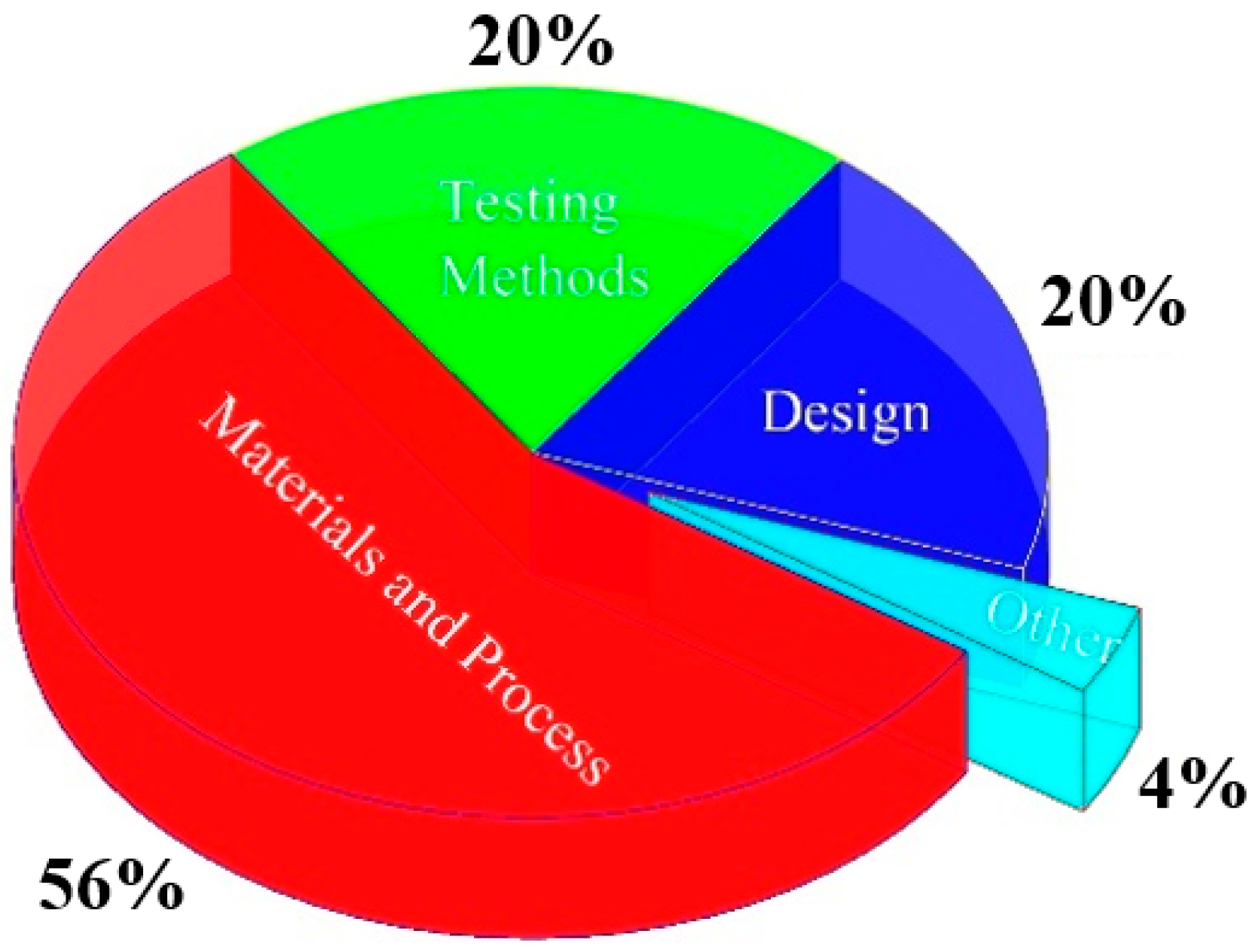


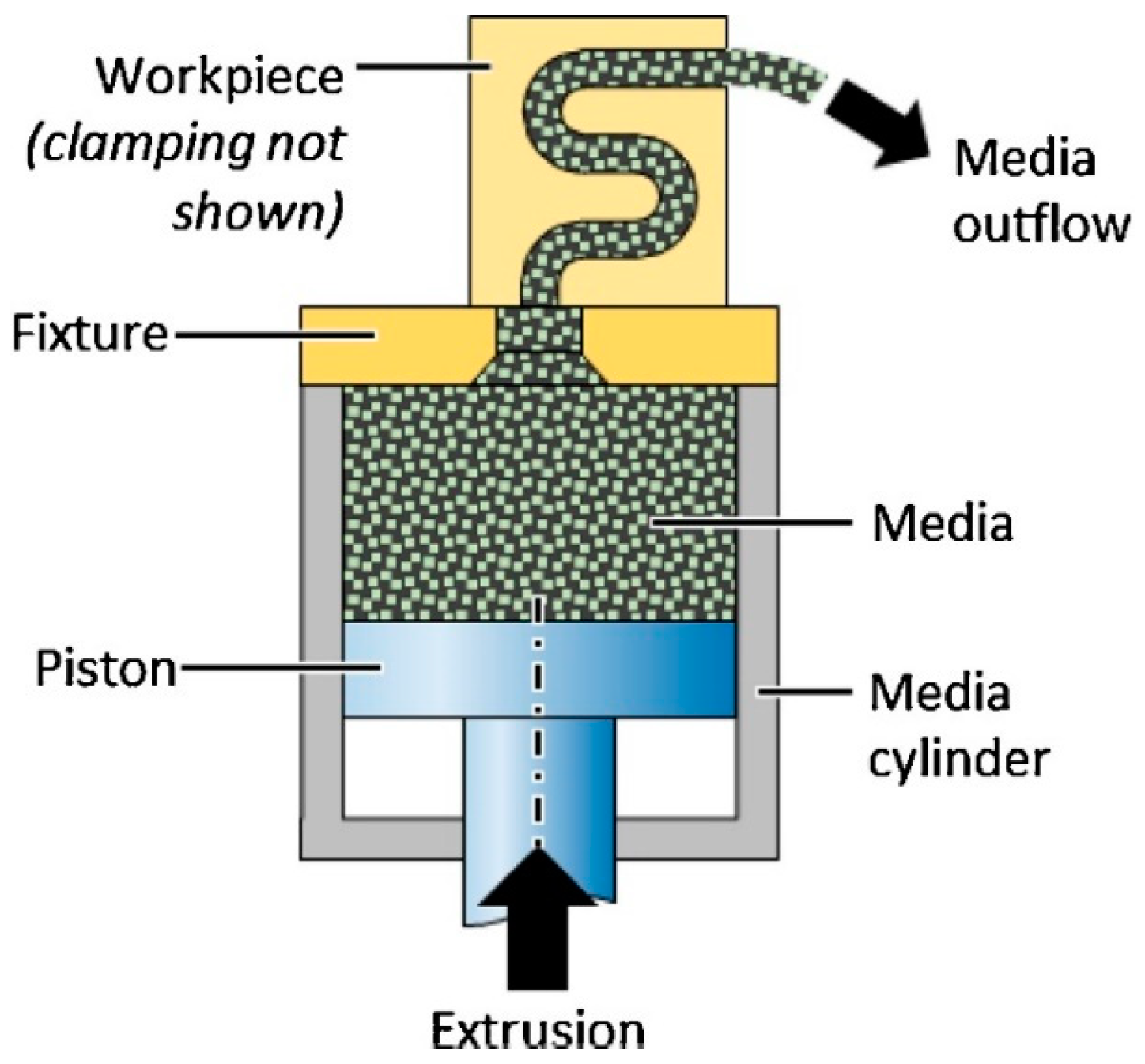
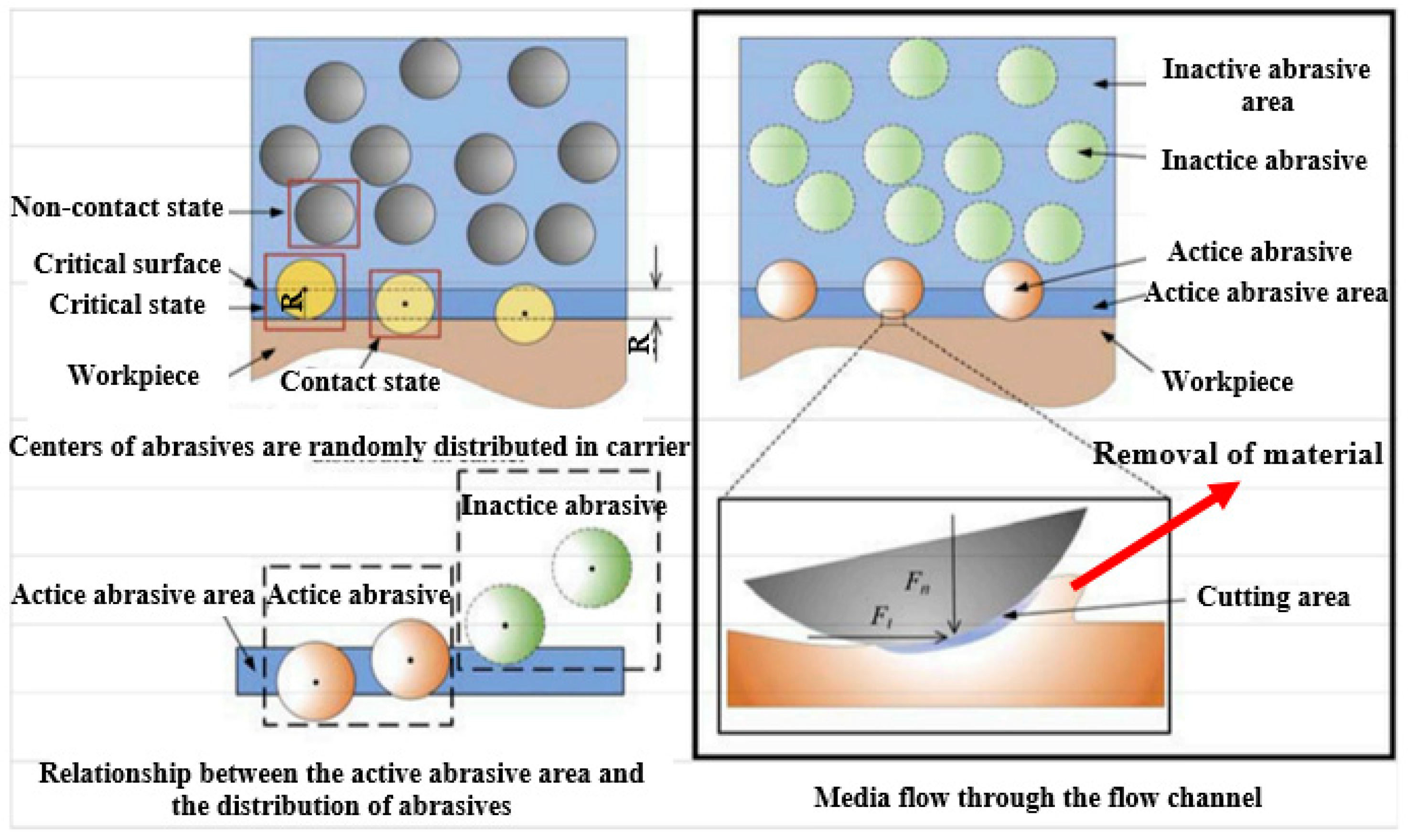
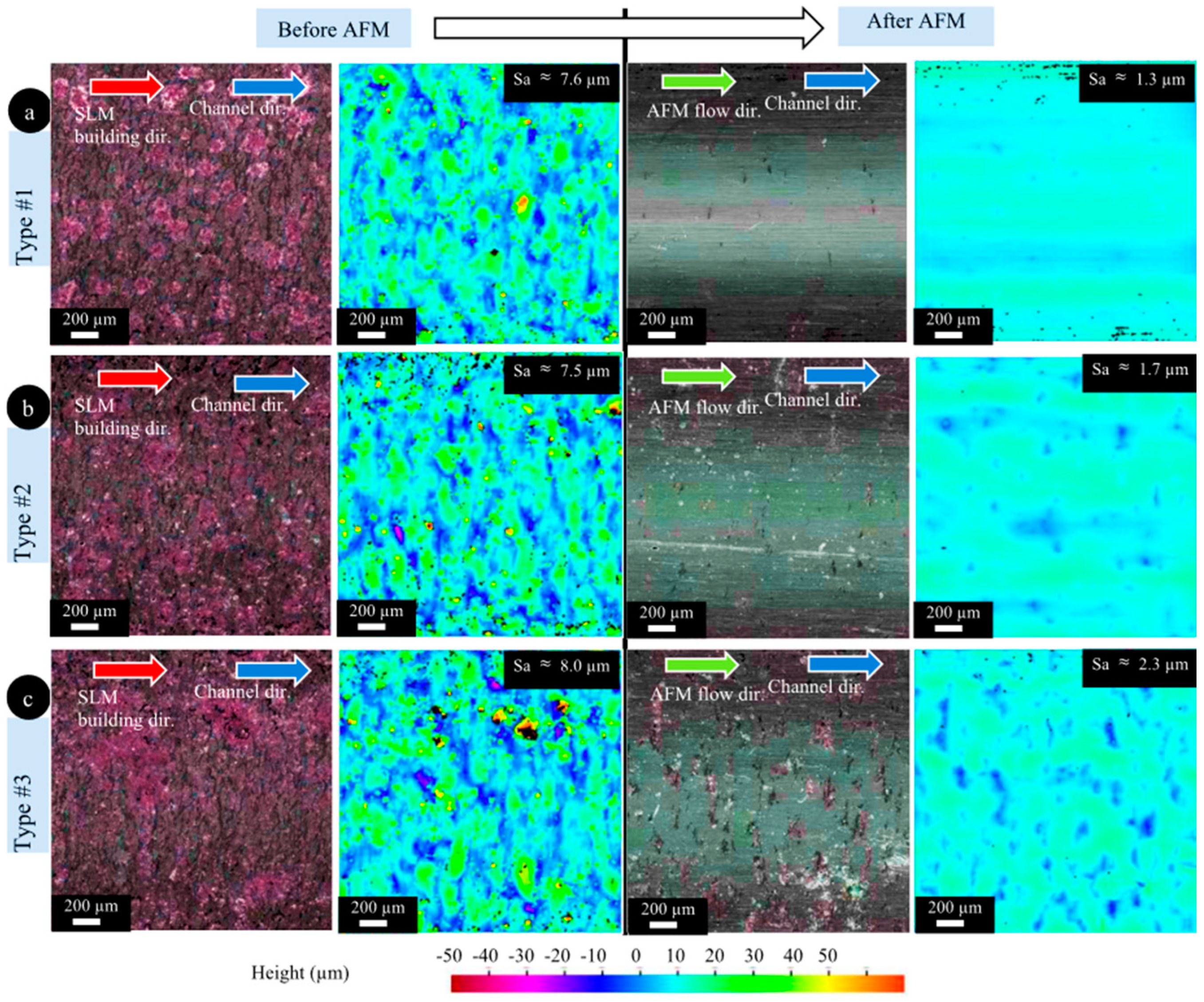
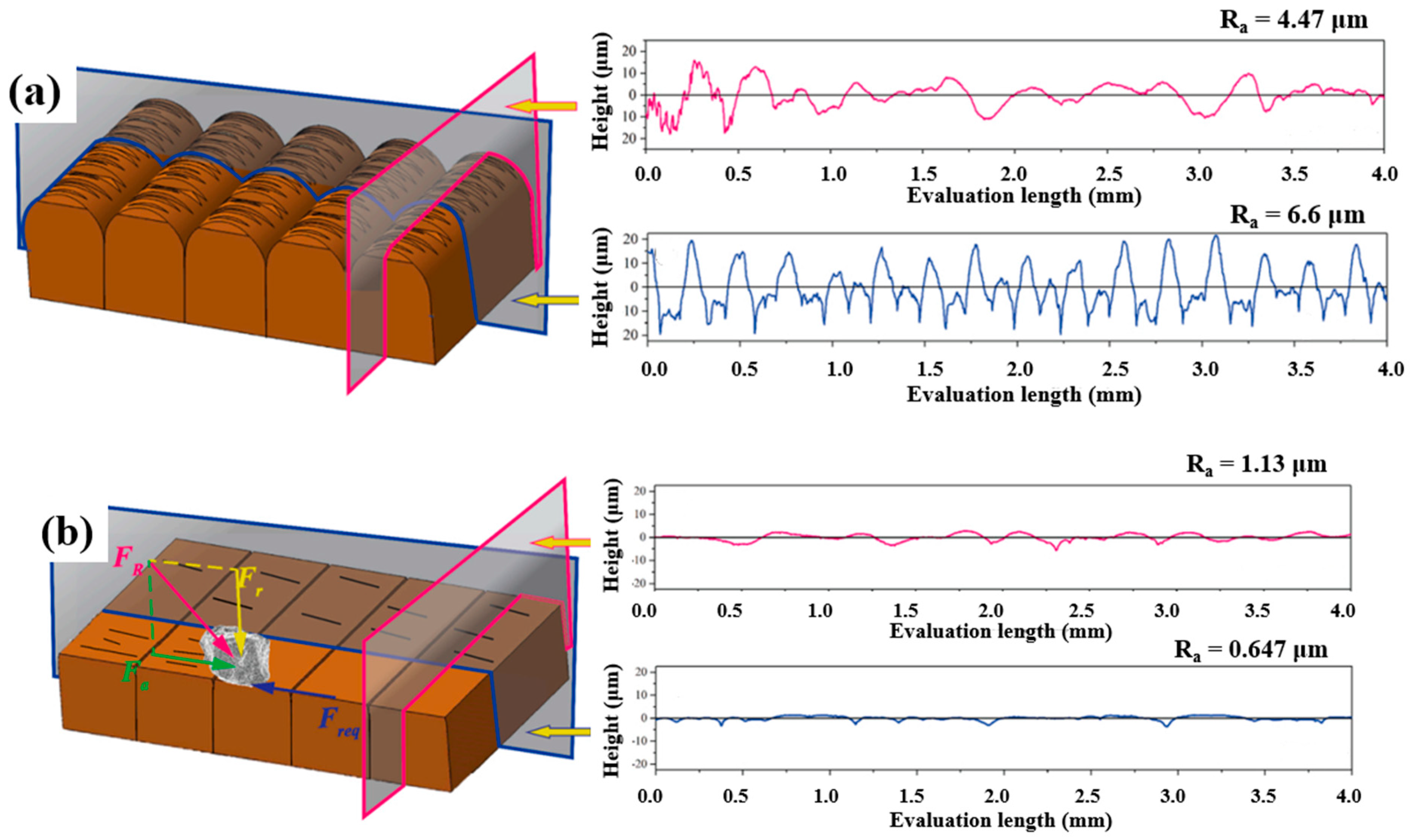


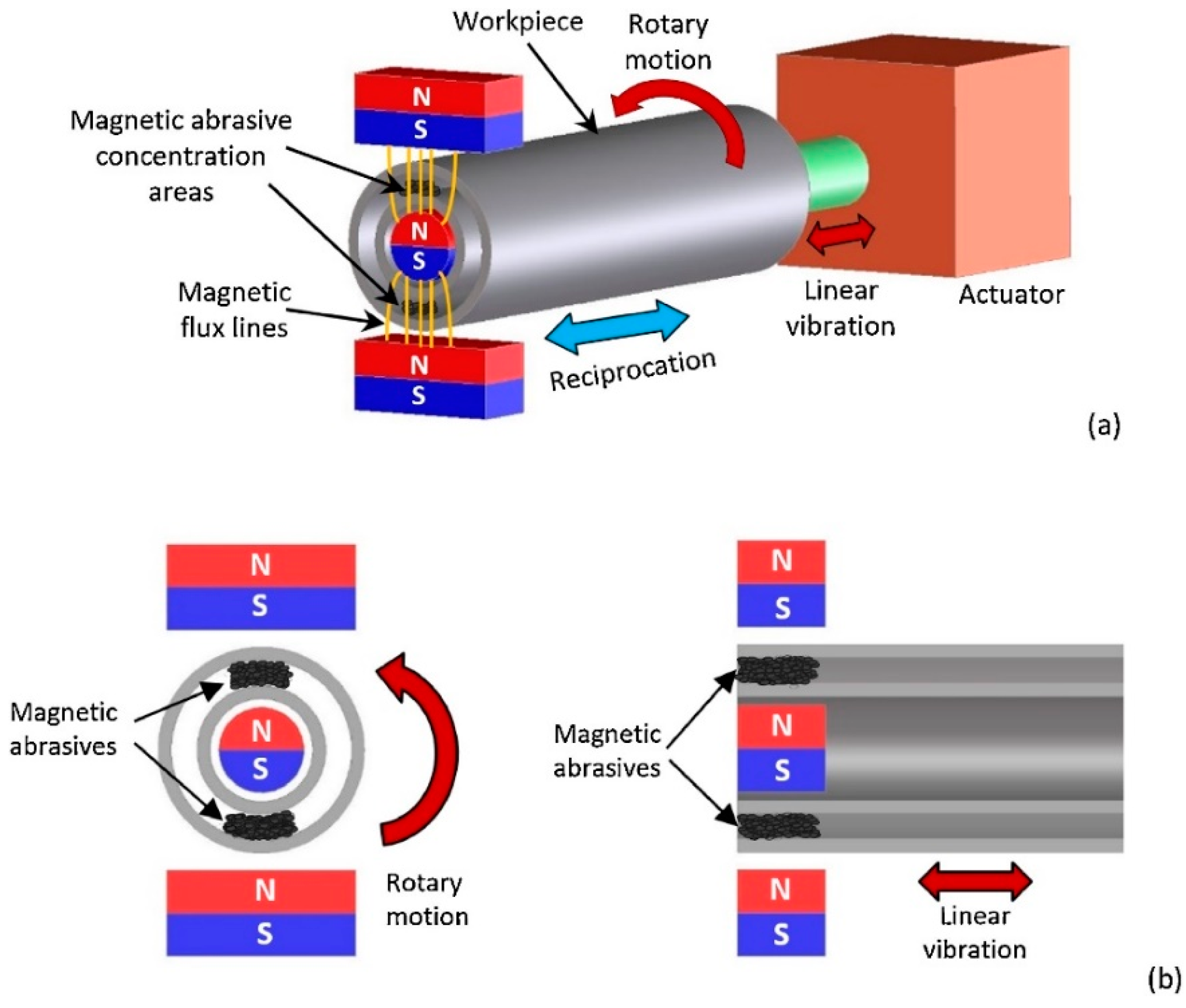
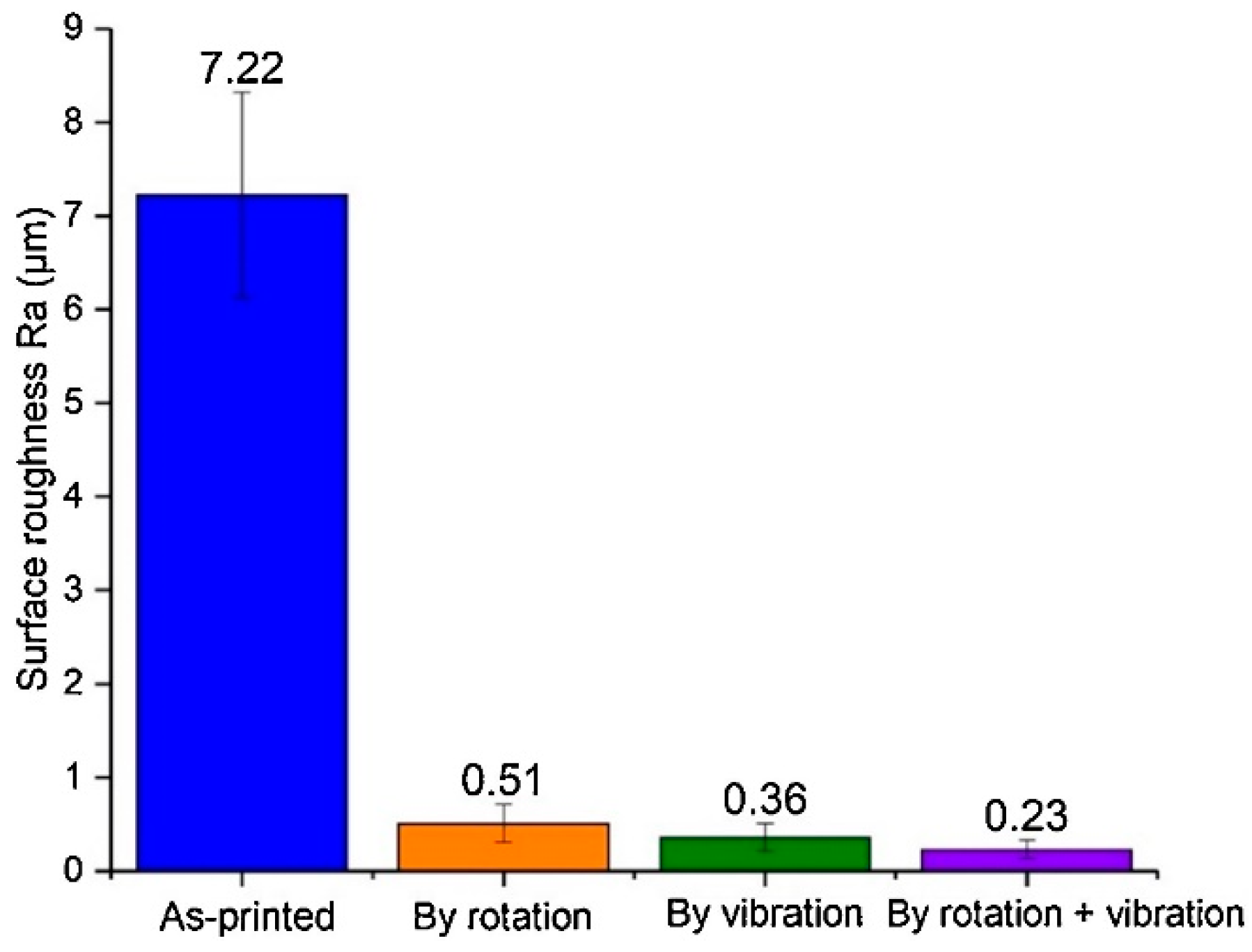
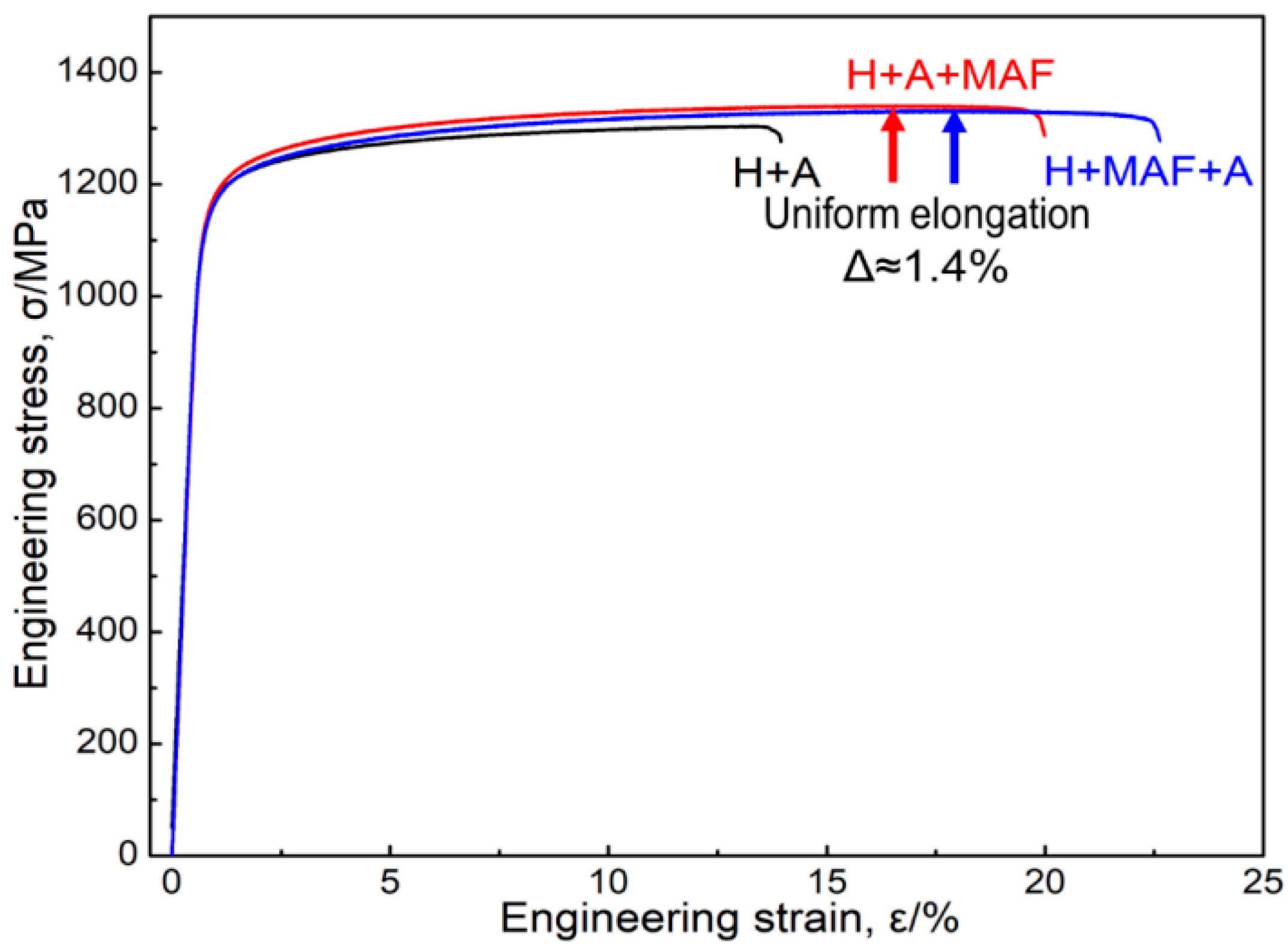
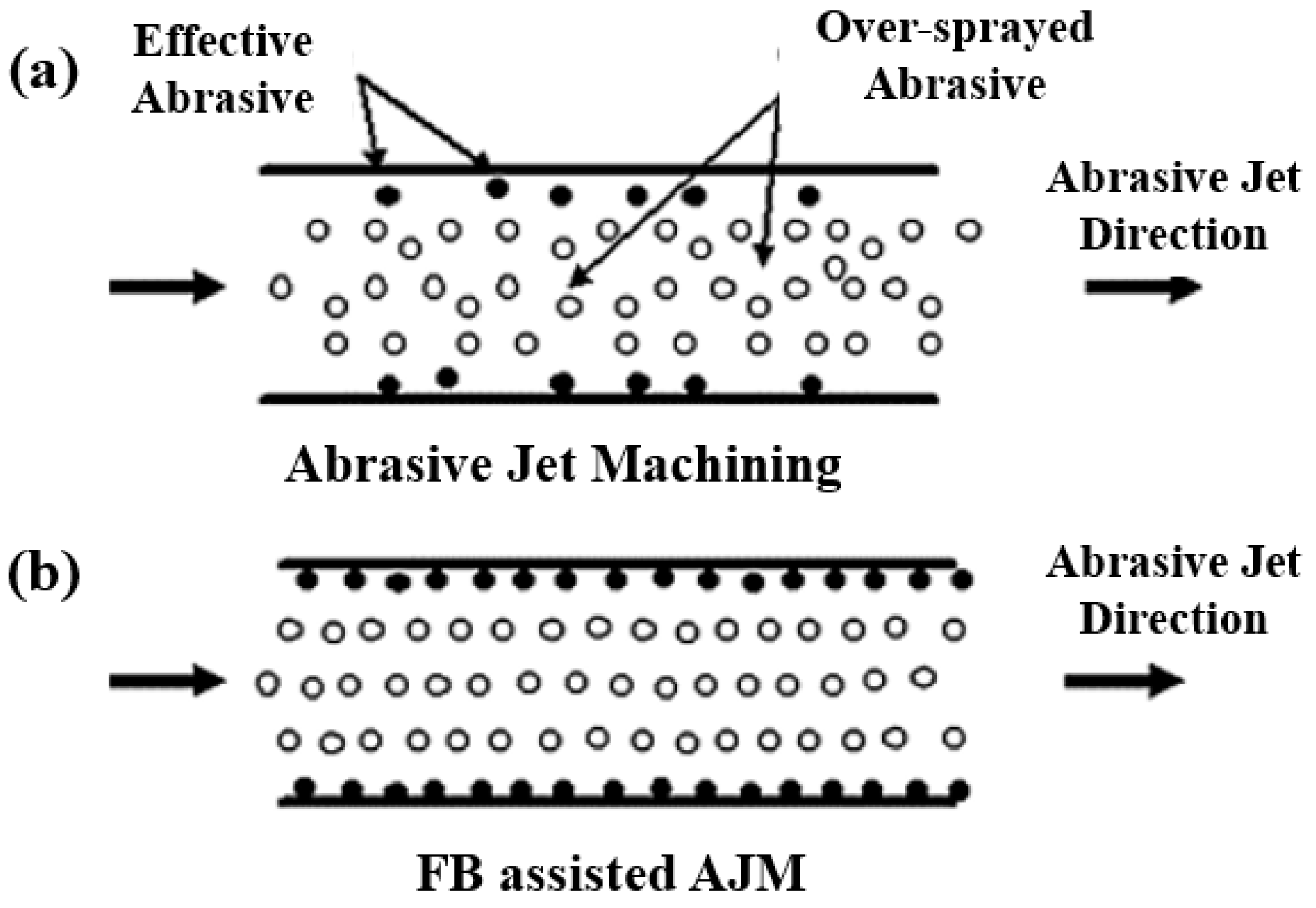
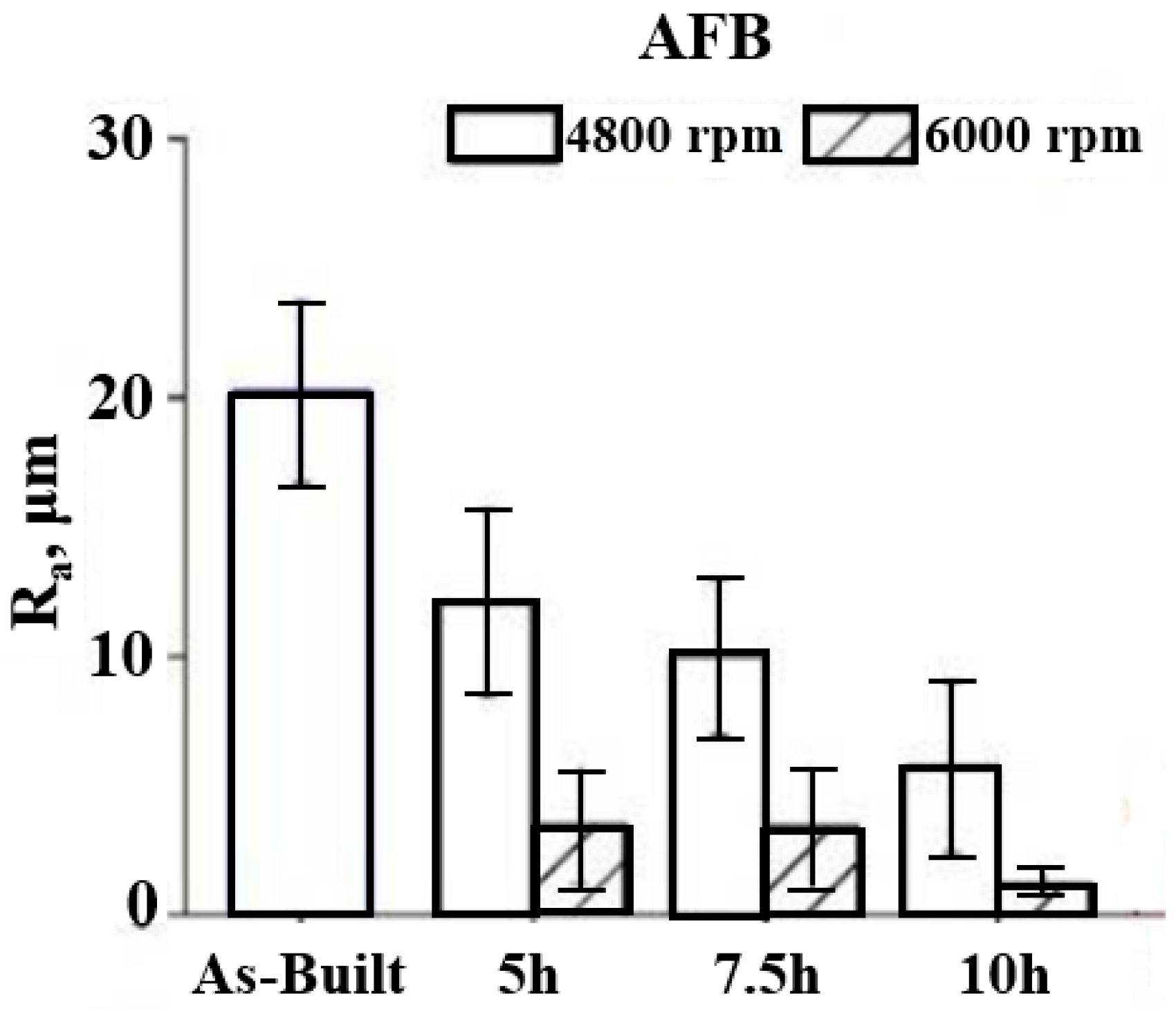
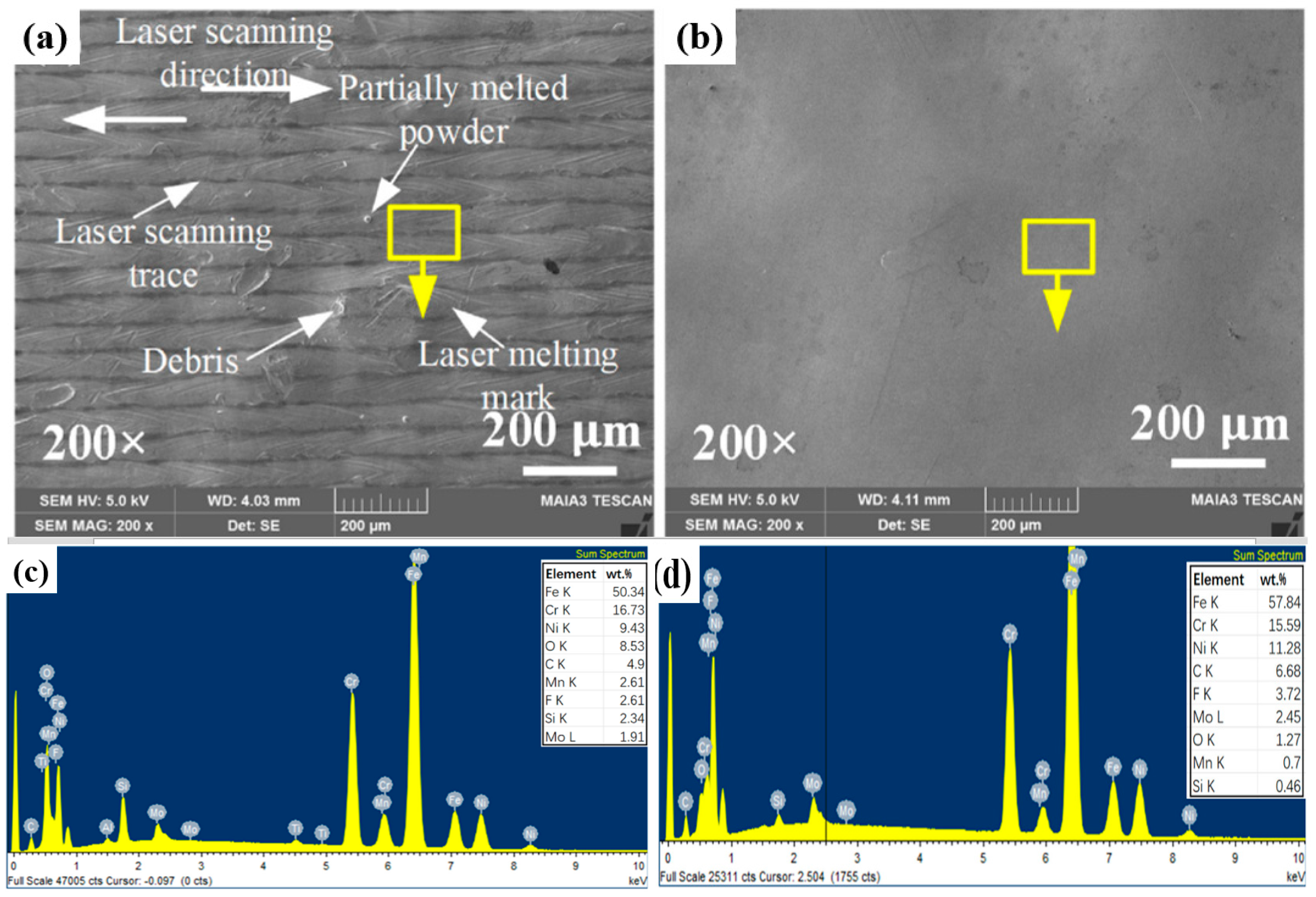

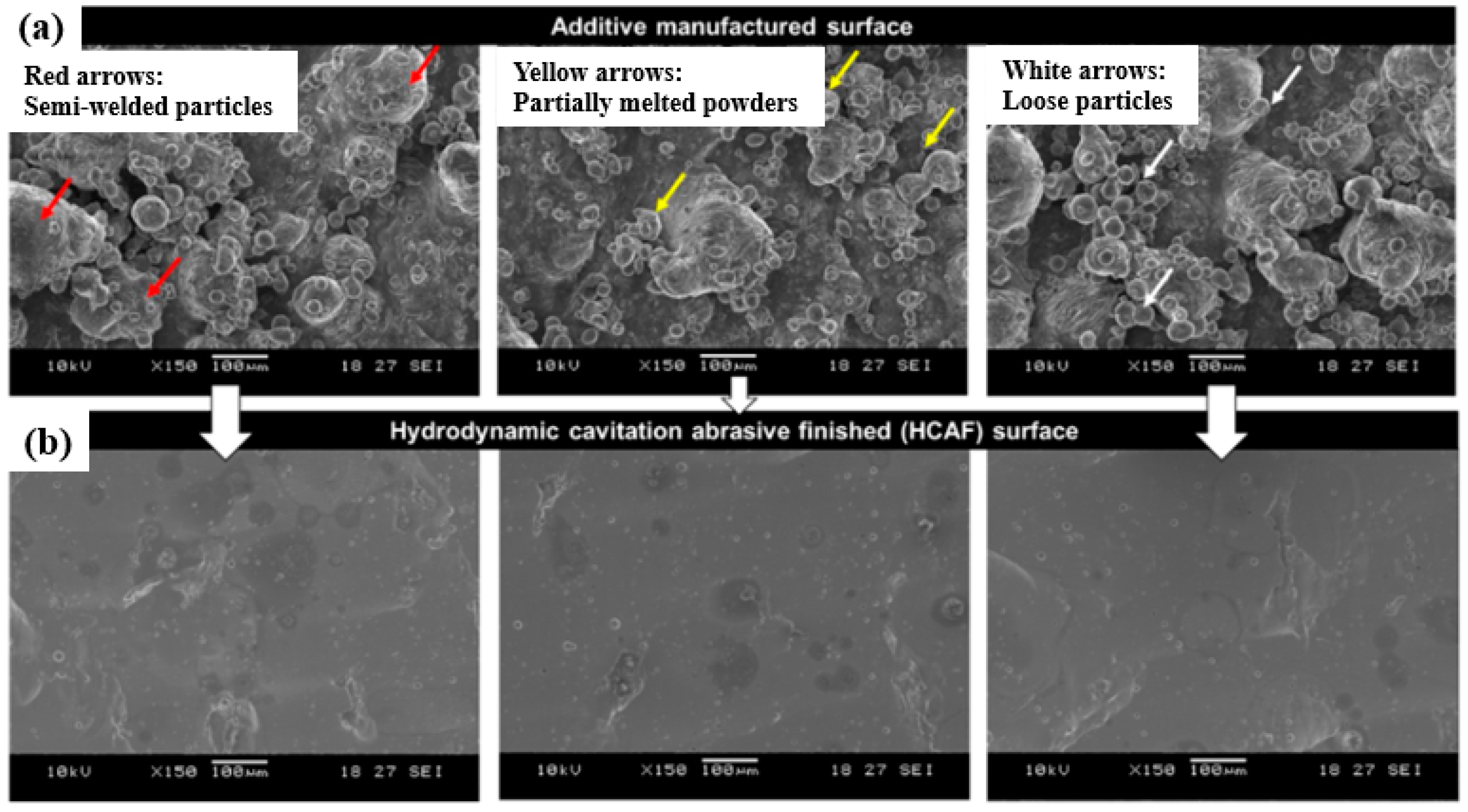

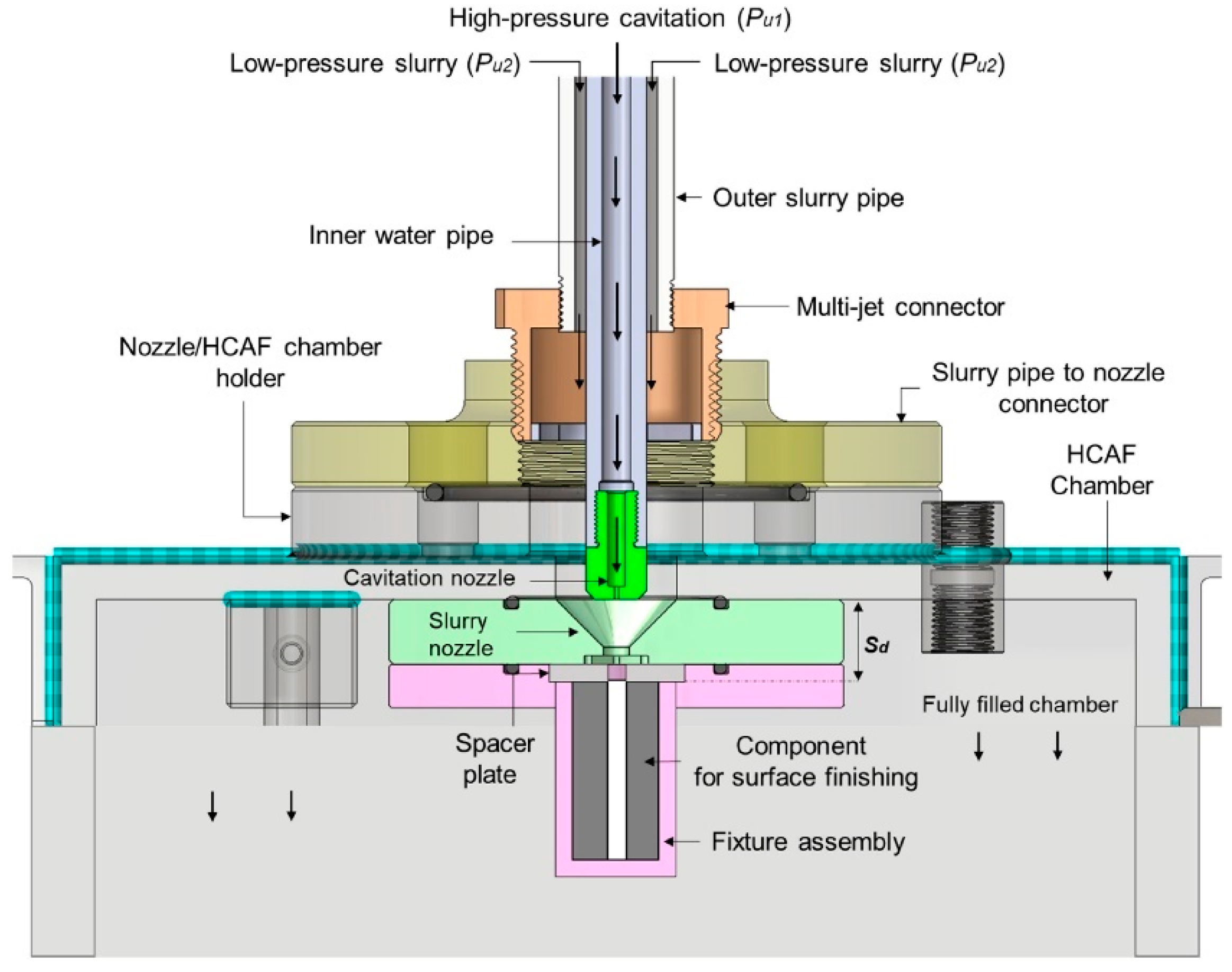
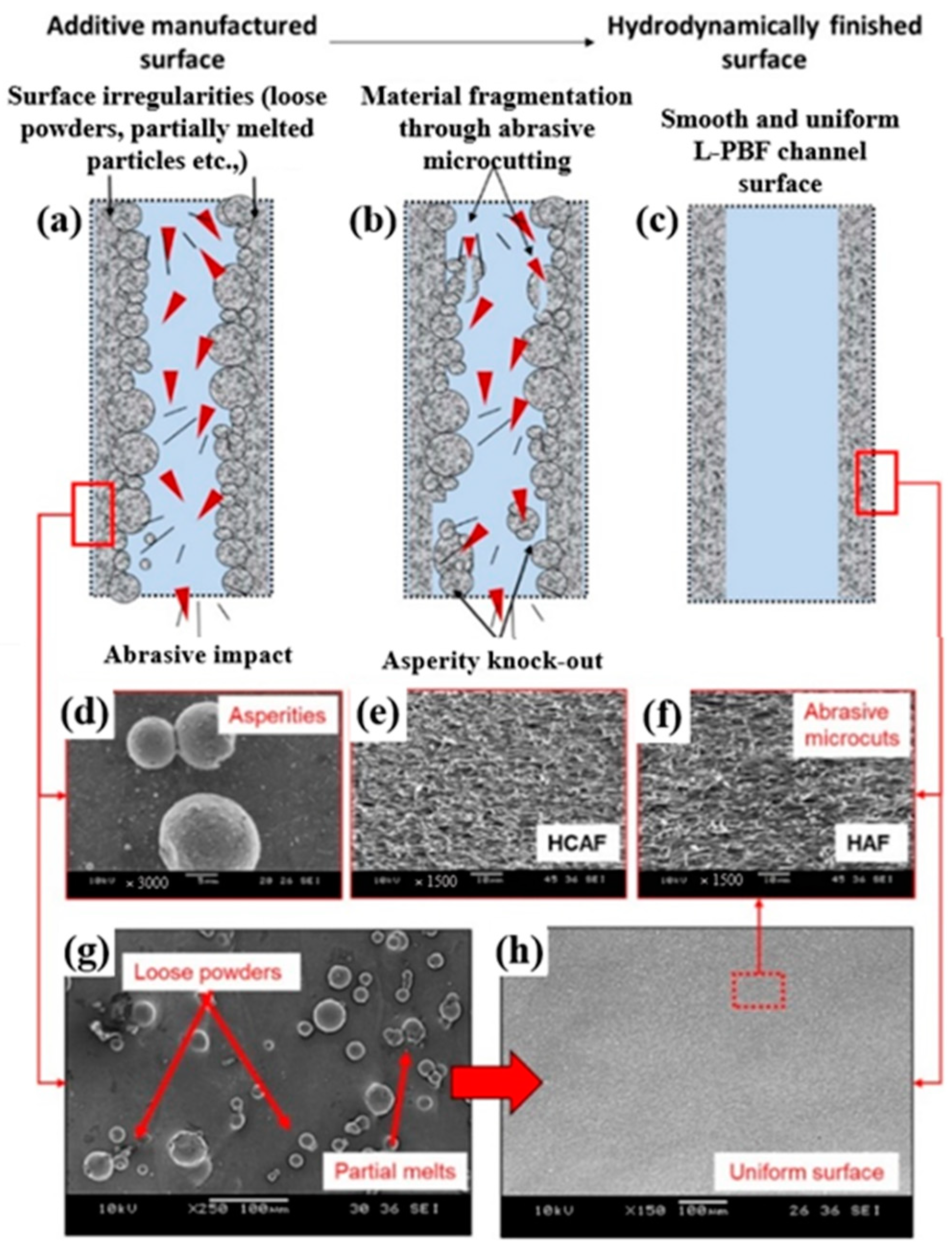
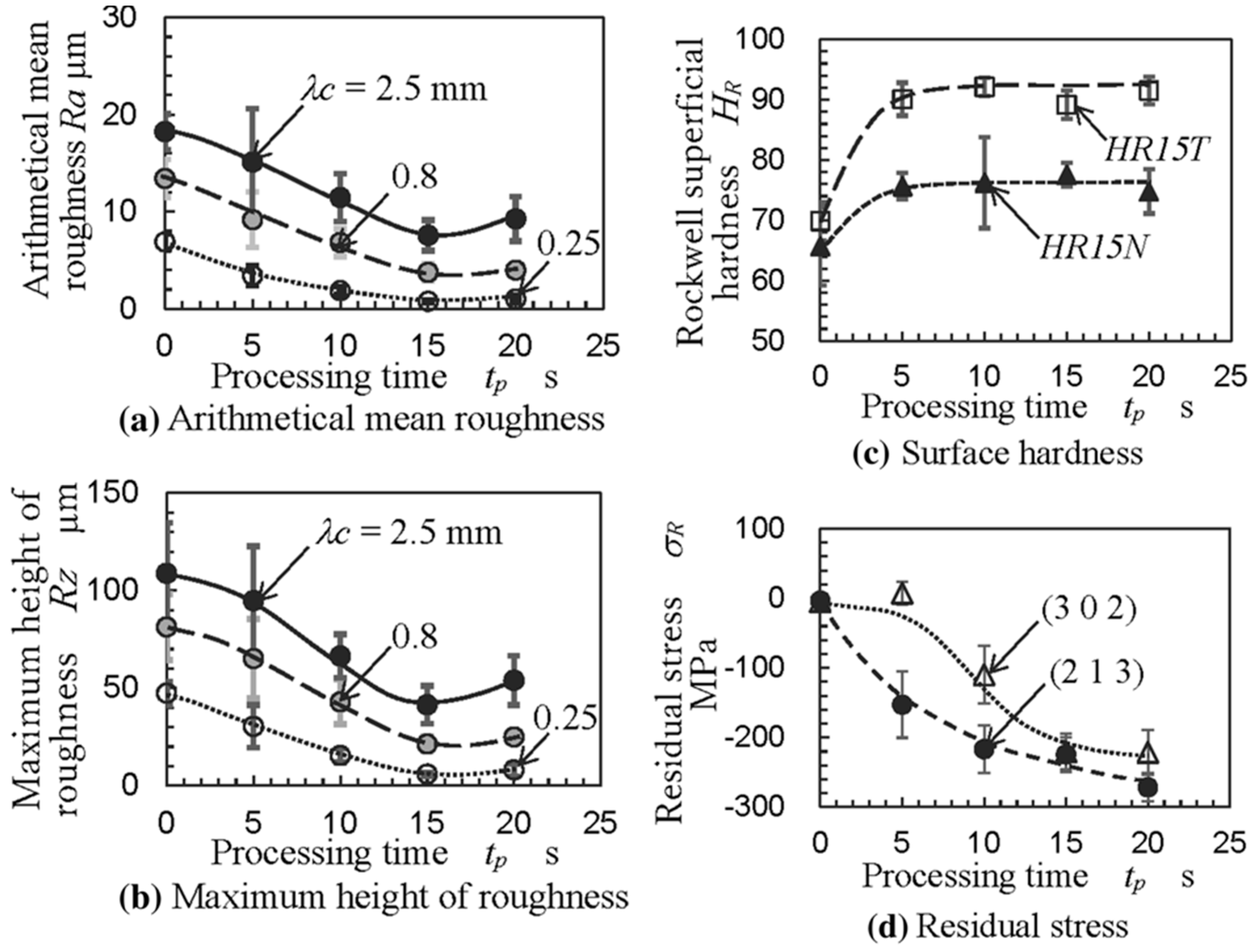
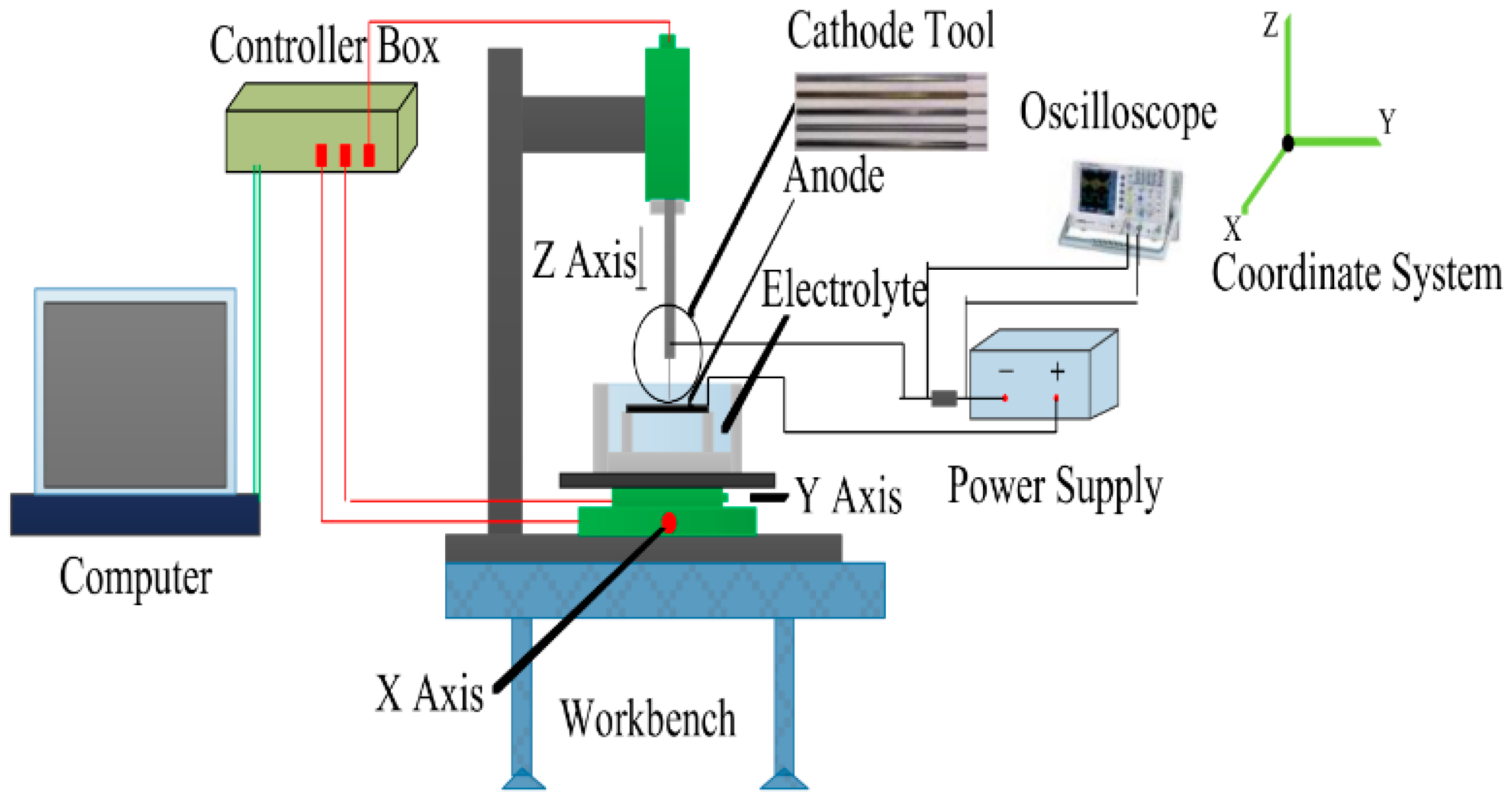

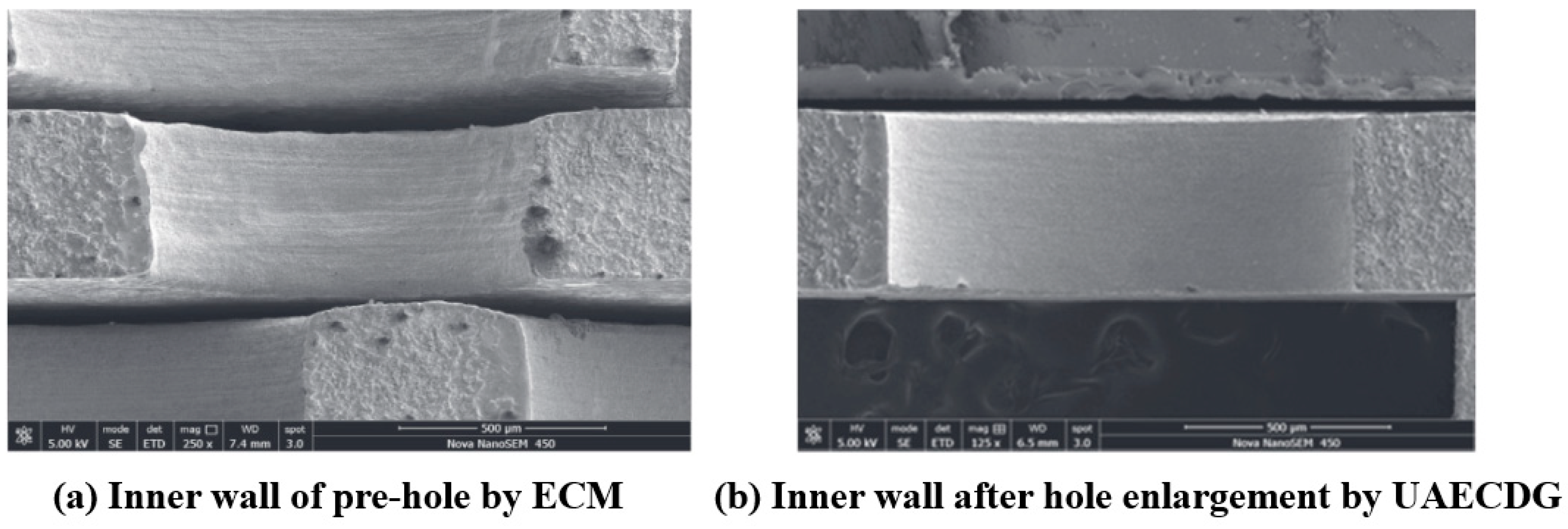
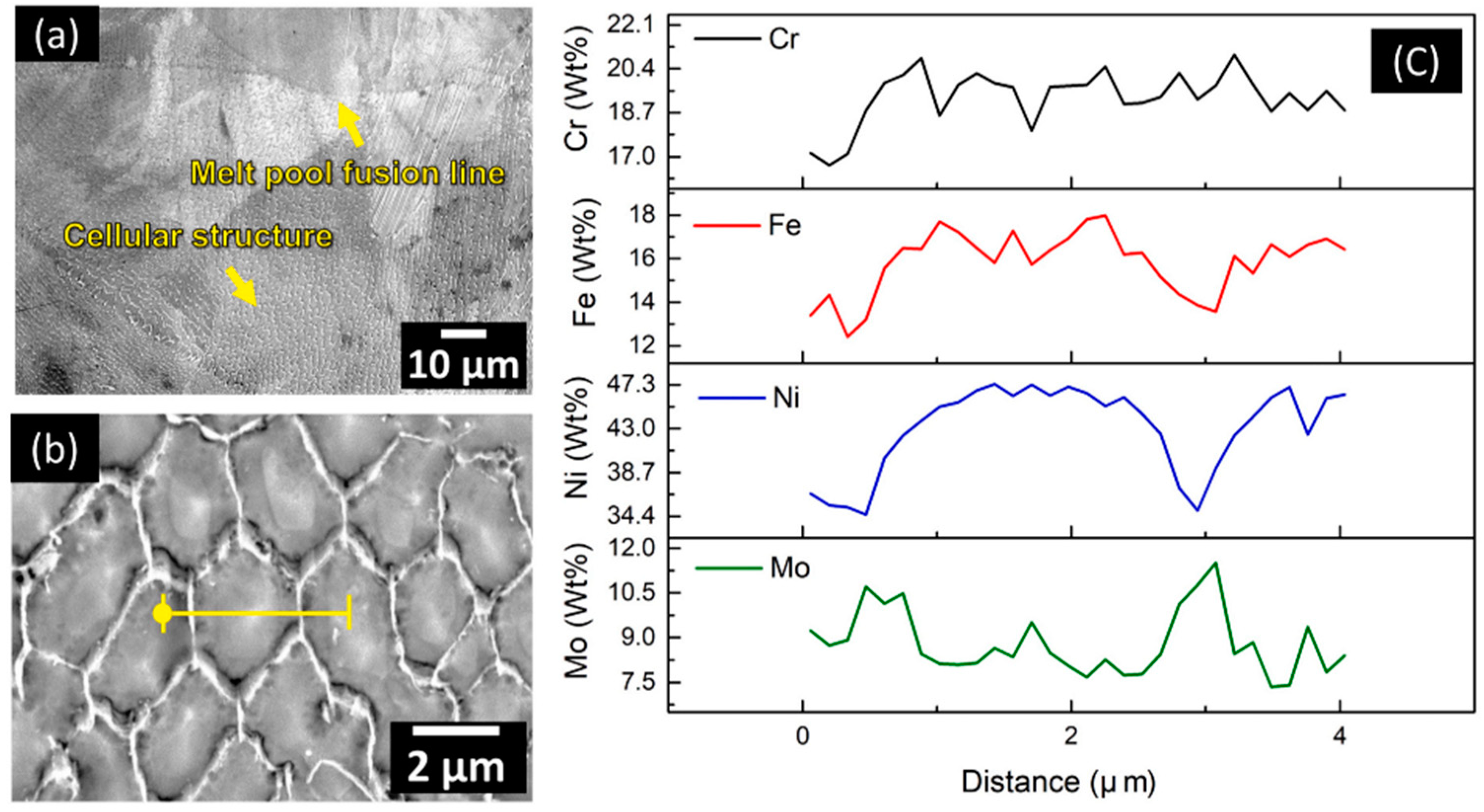
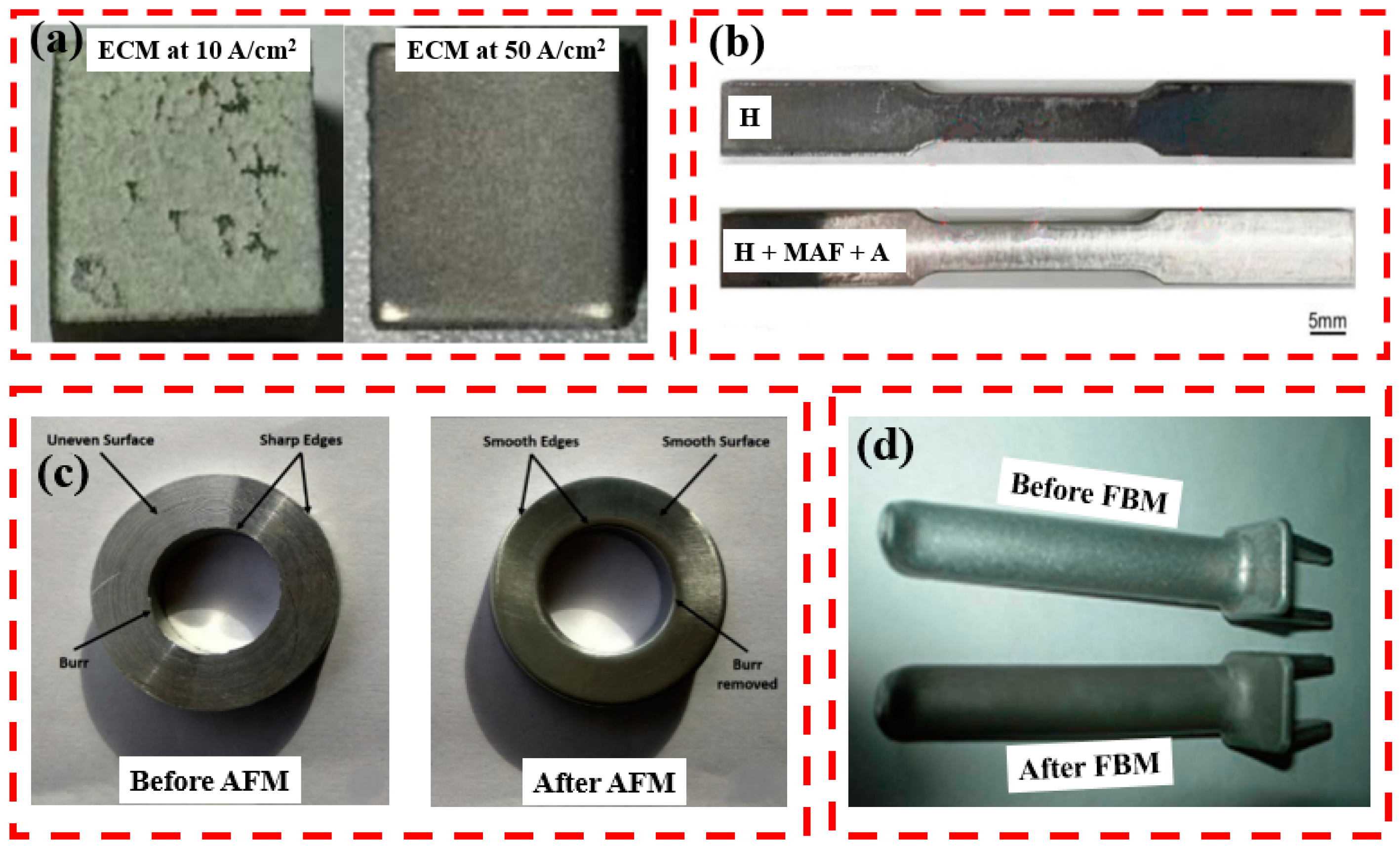
| Company | Process | Machine | Surface Roughness, Ra (μm) | Refs. |
|---|---|---|---|---|
| EOS GmbH | L-PBF | EOS M80, M100, M290, M300-4, M400, M400-4 | 9–50 | [34] |
| SLM Solution | L-PBF | SLM 125, 280, 500, 800 | 8–17 | [35] |
| Arcam EBM | EBM | A2 | 5.6 | [36] |
| Arcam EBM | EBM | A2X, Q10 Plus, Q20 Plus, Spectra L and H | Horizontal: 19–30 Vertical: 24–39 | [37] |
| Alloy/AM Technique | Internal Surface Finishing Technique | Mechanism of Material Removal | Advantages/ Limitations of the Finishing Process | Reduction Percentage of Ra | Refs. |
|---|---|---|---|---|---|
| Al and Ti grills/L-PBF | AFM | Through a pressurized flow of viscoelastic material loaded with abrasives, the material is removed from the internal surface of the workpieces. | Achievement of a high level of surface finish/Time-consuming process, especially for large workpieces, uneven finishing and contamination problems. | More than 90% | [153] |
| AlSi10Mg/L-PBF | HCAF | Using high-velocity liquid jets that pass through a cavitating zone generates microbubbles that implode near the surface of the workpiece and remove material through erosion, abrasion, and fatigue. | Uniform surface finish/Difficult to remove material from harder materials due to the microbubbles. | More than 90% | [28,86,154] |
| AFB | Using a fluidized bed of abrasive particles suspended in a high-velocity air stream impinges on the workpiece surface, removing material through a combination of impact, erosion, and abrasion. | Finishing large and irregularly shaped/Difficult to control the flow of the abrasive particles due to the high-speed impacts. | More than 90% | [155] | |
| Inconel 625/L-PBF | MJ-HCAF | Cavitation erosion and abrasive ploughing. | High material removal rate/Difficult to control the distribution of the abrasive particles. | 60–90% | [27] |
| UCAF | Using ultrasonic waves creates cavitation bubbles in a liquid abrasive slurry, collapsing near the workpiece’s surface and removing material through erosion, abrasion, and fatigue. | Workpiece of most materials/Limitations in ultrasonic wave propagation. | 40% | [32] | |
| Inconel 718/L-PBF | MAF | The relative motion between the internal workpiece surface and magnetic abrasive cluster removes material. | Suitable for non-ferromagnetic materials/Difficult to remove ferromagnetic materials. | 85% | [29] |
| 304 stainless steel/L-PBF | ECM | The use of an electrolyte and an electric current to dissolve the workpiece material and create the desired shape. | It can work on difficult-to-machine materials, need to not so complicated tools/Relatively slow process, It can be changed in environmental variables. | 55% | [156] |
| Electrochemical mechanical polishing (ECMP) | Electrochemical reactions and mechanical abrasion. | 70% | [157] | ||
| 316L stainless steel/L-PBF | ECM | The use of an electrolyte and an electric current to dissolve the workpiece material and create the desired shape. | It can work on difficult-to-machine materials, need to not so complicated tools/Relatively slow process, It can be changed in environmental variables | 60% | [158] |
| Electropolishing | Dissolution of the metal resulting in the reduction of thickness. | It can remove surface imperfections, such as burrs and scratches, without affecting the underlying material; suitable for complex shapes and internal surfaces, which can be challenging to finish with other methods/Expensive; it can be changed in environmental variables. | 80% | [159] | |
| Magnetically driven internal finishing (MDIF) | The use of magnetic fields to drive abrasive particles toward the materials’ removing. | Finishing the complex internal surfaces and highly controlled and precise process/The magnetic field strength and the abrasive particle size can affect the process. | More than 90% | [160] | |
| Multi-jet polishing (MJP) | Using high-velocity liquid jets impacts the surface of the workpiece and removes material through erosion. | Finishing the complex surfaces/Difficult to remove large amounts of material or to work on harder materials. | More than 90% | [105] |
| Ref. | Method | Component Shape-Materials | Apparatus Requirement | Roughness Change (µm) | Limitations | Complexity | Post/Pre-Processing Conditions |
|---|---|---|---|---|---|---|---|
| [161] | R-AFF | Hollow cylinder—Al and Al/SiC |
| 0.4→0.3 |
| Simple | Pre-processing |
| [5] | R-AFF | Hollow cylinder—Al and Al/SiC |
| 0.3→0.2 |
| Simple | Pre-processing |
| [69,70] | UAAFM | Bevel gear—steel |
| 1.8→1.3 |
| Complex | Pre-processing |
| [92] | MAF | Turned tube—Ly12 aluminum |
| 9.6→0.2 |
| Complex | Pre-processing and post-processing |
| [92] | MAF | A small tube (40 mm with 30 Ø)—316L stainless steel |
| 0.8→0.1 |
| Simple | Pre-processing and post-processing |
| [162] | MAF-Gel | Cylindrical road (65 mm with 15 Ø)—SKD11 and HRC60 |
| 0.70→0.04 |
| Simple | Pre-processing and post-processing |
| [97] | AFB | Square sheets with a side dimension of 40 and 1 mm in thickness—2024 aluminium alloys |
| 1.0→0.4 |
| Complex | Post-processing |
| [99] | FB-AJM | Circular tube: length 200 mm and the inner diameter is 12 mm stainless steel 316L |
| 1.5→0.1 |
| Complex | Post-processing |
| [101] | FB-AJM | A long and narrow tube—aluminium alloy (AA 6082 T6) |
| 4.00→0.65 |
| Complex | Post-processing |
| [163] | Drag finishing combined with fluidized bed | Rings with 10 mm long and 21 and 25 mm in inner and outer diameter—brass (Cu-30 wt.% Zn) |
| 3.0→0.2 |
| Simple and External surface | Post-processing |
| [142] | EMAF | Cubic shape—Al 6061 |
| 1.3→0.2 |
| Simple | Pre-processing |
| [146] | UEF | Cylindrical hole—AISI H13 |
| 1.3→0.2 |
| Complex | Pre-processing |
| [164] | Electro-polishing | Rectangular shape—pure Ti foils (Grade 2, 99.5%) |
| 0.05→0.00Mirror-like surface |
| Simple | Post-processing |
| [103] | AFB | Axial-symmetric geometry typical of fatigue test—Ti6Al4V |
| 2.0→10.0 |
| Complex | Post-processing |
| [68] | MAFM | SiC/B4C hybrid MMCs with aluminum as a base material |
| 1.0→2.0 |
| Simple | Pre-processing and post-processing |
| [64] | AFF | Gear—20MnCr5 alloy steel |
| 7.0→1.0 |
| Simple | Pre-processing |
| [65] | AFM | Rectangular cube with holes—18Ni (300) maraging steel |
| 3.0→0.5 |
| Simple | Pre-processing and post-processing |
| [63] | AFF | Tube—copper |
| 6.0→1.2 |
| Simple | Pre-processing |
| [165] | MAF | AISI H13 hot die steel |
| 0.7→0.2 |
| Simple | Pre-processing and post-processing |
| [110] | MJ-HCAF | Rectangular cube—L-PBF Inconel 625 |
| 3.0→1.0 |
| Simple | Post-processing |
| [144] | EMAF | Stainless steel of SUS304 |
| 0.20→0.04 |
| Simple | Pre-processing and post-processing |
| [166] | RAU-AFF | Al 6061 |
| 4.8→3.4 |
| Complex | Pre-processing |
| [71] | UA-RMRAFF | Tubes—Al2024 |
| 0.96→0.05 |
| Complex | Pre-processing |
| [88] | MAF | Cubes and tensile bars—Inconel 718 superalloys |
| 2.70→0.15 |
| Simple | Post-processing |
| [148] | UAECDG | Hole—304 stainless steel |
| 1.4→0.3 |
| Complex | Pre-processing |
| Items | Roughness Improvement (20%) | Internal Surface Finishing (10%) | Size of Components (10%) | Complex-Shape Components (20%) | Possibility of Finishing the Al and Ti Products (10%) | Cost of Operation (10%) | Pre-Processing Score (20%) | Post-Processing Score (20%) | Total Pre-Processing | Total Post-Processing | |
|---|---|---|---|---|---|---|---|---|---|---|---|
| Techniques | |||||||||||
| R-AFF | |||||||||||
| U-AFF | |||||||||||
| MAF | |||||||||||
| MAF-Gel | |||||||||||
| AFB | |||||||||||
| FB-AJM | |||||||||||
| Drag finishing + Fluidized bed | |||||||||||
| EMAF | |||||||||||
| UEF | |||||||||||
| Electro polishing | |||||||||||
| Score | |||||||||||
| 1 | 5 | ||||||||||
Disclaimer/Publisher’s Note: The statements, opinions and data contained in all publications are solely those of the individual author(s) and contributor(s) and not of MDPI and/or the editor(s). MDPI and/or the editor(s) disclaim responsibility for any injury to people or property resulting from any ideas, methods, instructions or products referred to in the content. |
© 2023 by the authors. Licensee MDPI, Basel, Switzerland. This article is an open access article distributed under the terms and conditions of the Creative Commons Attribution (CC BY) license (https://creativecommons.org/licenses/by/4.0/).
Share and Cite
Davoodi, F.; Taghian, M.; Carbone, G.; Saboori, A.; Iuliano, L. An Overview of the Latest Progress in Internal Surface Finishing of the Additively Manufactured Metallic Components. Materials 2023, 16, 3867. https://doi.org/10.3390/ma16103867
Davoodi F, Taghian M, Carbone G, Saboori A, Iuliano L. An Overview of the Latest Progress in Internal Surface Finishing of the Additively Manufactured Metallic Components. Materials. 2023; 16(10):3867. https://doi.org/10.3390/ma16103867
Chicago/Turabian StyleDavoodi, Farideh, Mohammad Taghian, Giuseppe Carbone, Abdollah Saboori, and Luca Iuliano. 2023. "An Overview of the Latest Progress in Internal Surface Finishing of the Additively Manufactured Metallic Components" Materials 16, no. 10: 3867. https://doi.org/10.3390/ma16103867
APA StyleDavoodi, F., Taghian, M., Carbone, G., Saboori, A., & Iuliano, L. (2023). An Overview of the Latest Progress in Internal Surface Finishing of the Additively Manufactured Metallic Components. Materials, 16(10), 3867. https://doi.org/10.3390/ma16103867









